













The idea behind this dictionary, or glossary, if you will, first came about when I started researching Indian desserts. As I immersed myself deeper and deeper into the subject I soon began to drown in the sheer quantity of it all. So, to keep my head at  least partially above water I began to develop a sort of taxonomy of dessert. For though the genus of dessert is vast, you can make some sense of it if you break it down into its constituent species and subspecies. There are, for example many kinds of halvah in India but they are all made using more or less the same technique. You could say much the same about American pies or Viennese tortes. The names can be baffling however, thus my attempt to compile them here. I realize this is ultimately a futile task, and that this will remain a perpetual beta. If Wikipedia can’t list them all (or get the facts right) how can I presume to do better? Well, at least I can make a start. And if you have any suggestion, corrections or additions please let me know. I will credit one and all.
least partially above water I began to develop a sort of taxonomy of dessert. For though the genus of dessert is vast, you can make some sense of it if you break it down into its constituent species and subspecies. There are, for example many kinds of halvah in India but they are all made using more or less the same technique. You could say much the same about American pies or Viennese tortes. The names can be baffling however, thus my attempt to compile them here. I realize this is ultimately a futile task, and that this will remain a perpetual beta. If Wikipedia can’t list them all (or get the facts right) how can I presume to do better? Well, at least I can make a start. And if you have any suggestion, corrections or additions please let me know. I will credit one and all.
The idea behind this dictionary, or glossary, if you will, first came about when I started researching Indian desserts. As I immersed myself deeper and deeper into the subject I soon began to drown in the sheer quantity of it all. So, to keep my head at least partially above water I began to develop a sort of taxonomy of dessert. For though the genus of dessert is vast, you can make some sense of it if you break it down into its constituent species and subspecies. There are, for example many kinds of halvah in India but they are all made using more or less the same technique. You could say much the same about American pies or Viennese tortes. The names can be baffling however, thus my attempt to compile them here. I realize this is ultimately a futile task, and that this will remain a perpetual beta. If Wikipedia can’t list them all (or get the facts right) how can I presume to do better? Well, at least I can make a start. And if you have any suggestion, corrections or additions please let me know. I will credit one and all.
alfajores South AmericaA filled cookie sandwich popular in Peru and Argentina. The recipe varies according to the location. In Peru, it is like a super soft sablé or shortbread cookie with a dulce de leche filling (Traditional version). The sablé can be chocolate instead of vanilla and the filling can be honey or specifically algarrobo honey (from Prosopis pallida, a desert tree), or dulce de leche mixed with a fruit purée (popular flavors include lúcuma [Pouteria lucuma], cherimoya or guanabana (soursop). The Argentinian version is dipped in chocolate; the cookies are not as soft. Thanks to Aracelli Zea.
aruheito JapanA candy molded into lozenges or more fanciful shapes. From the Portuguese alfeloa.
asure TurkeyA sweet, wheatberry pudding made with dried fruits.
Auflauf Austria/GermanyA sort of soufflé or baked pudding lightened by the addition of whipped egg whites. An auflauf can be either sweet and savory.
baba France, babà ItalyIn the eighteenth century, French cooks adapted the central European Kugelhupf under the Polish name “baba.” The popularization of the dessert (and even occasionally its invention) in France is widely ascribed to the exiled Polish king Stanislaw Leszczynski and/or his cook Nicolas Stohrer. Early versions of the recipe yielded a buttery, yeast-leavened cake flavored with saffron and cooked in a ring pan. Sometime in the early nineteenth century cooks began soaking the cooked cake in rum syrup, the version familiar today in both France and Italy.
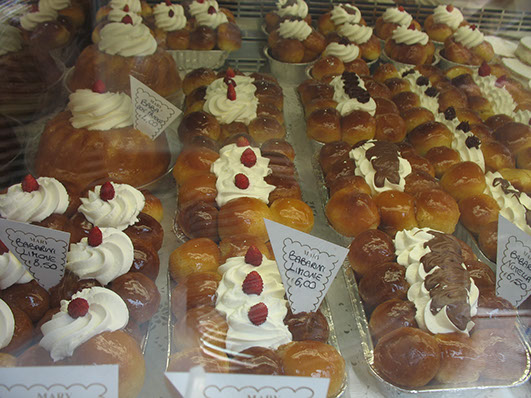
bagatelle QuebecDiced sponge cake covered with pudding and strawberry jam on the side, or at least that's the was served at one diner in rural Quebec. Most recipes have you layer the jam with the cake and pudding, others include fruit à la English trifle.
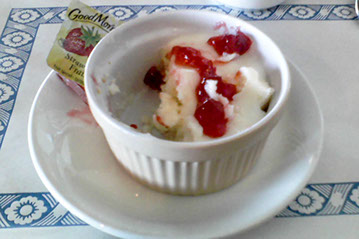
bahla Morocco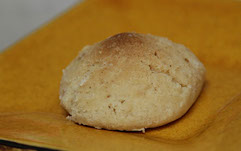 A brittle, small, round cookie often containing sesame, almonds and spices.
A brittle, small, round cookie often containing sesame, almonds and spices.
baklava Southeastern Europe & Middle EastBaklava is made by layering sheets of yufka (filo) with butter. This is then baked and soaked with sugar syrup (Greeks often add some honey). In the version mostly commonly sold in pastry shops there is a middle layer of nuts sandwiched between some 10-20 sheets of filo on top and bottom. Rustic versions contain no nuts, while  others have a cream filling and very early Ottoman recipes even include sweetened lentils in the filling. While the idea of layering thin layers of dough may date back to medieval Arab civilizations or possibly even Ancient Rome, baklava as we know was probably developed in or around Istanbul/Constantinople soon after the Ottoman conquest.
others have a cream filling and very early Ottoman recipes even include sweetened lentils in the filling. While the idea of layering thin layers of dough may date back to medieval Arab civilizations or possibly even Ancient Rome, baklava as we know was probably developed in or around Istanbul/Constantinople soon after the Ottoman conquest.
barfi (also burfi) South AsiaThis is made by cooking down milk along with sugar to a fudge-like consistency. The mixture can be colored, flavored with nuts, legumes, fresh or dried fruit, spices and even carrots. Sometimes the milk is omitted resulting in a texture closer to marzipan. You’ll see it cut into squares like American fudge, formed into balls, layered or rolled into multicolored slices and decorated with ground nuts, dried milk, coconut or silver foil.
bekkan JapanLiterally, “softshell tortoise” this dish is made from Chinese yam, flour and sugar. It is steamed and shaped to look like a tortoise.
boro Japancookie
Bavarian cream U.S./U.K., bavarvois Francecoming soon
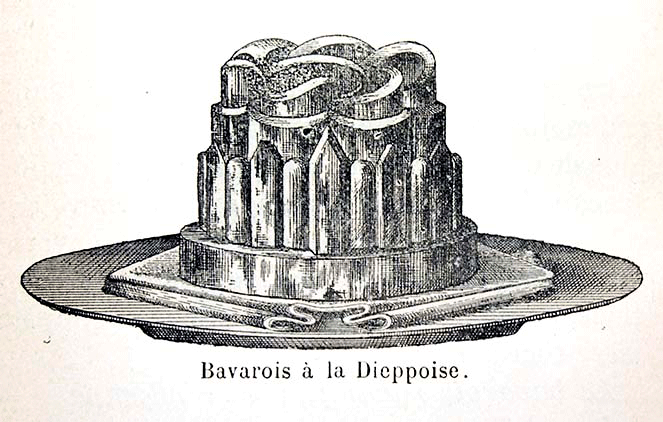
biscotto ItalyLiterally "twice-cooked" these cookies have become popular around the world. The origin of the concept seems to lie in ship's biscuit, which was, to all intents and purposes bread, baked and re-baked in slices to improve its keeping qualities. Sometime in the Renaissance, Italians started applying the same technique to cake, a practice that was picked up by the French and others. In much the same way that the British and French use the word "biscuit" for a cookie. The Italian biscotto (pl. biscotti) refers to just about any cookie, twice cooked or not
.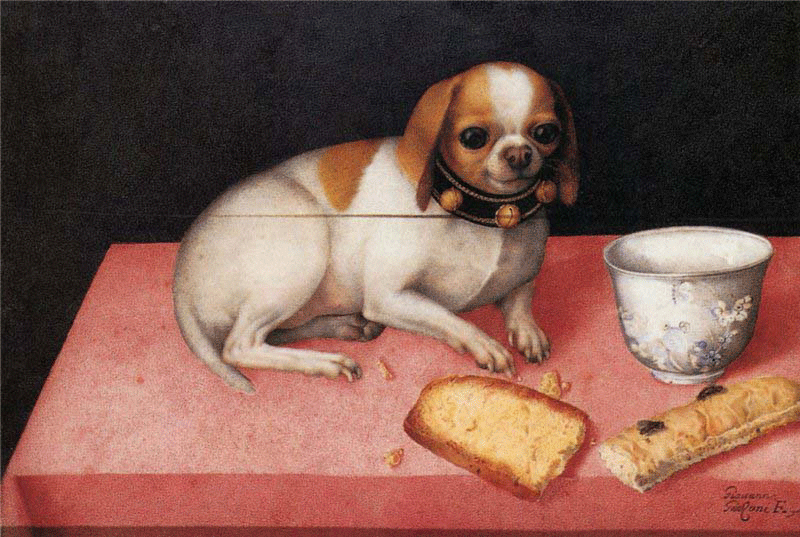
bizcocho SpainSee sponge cake.
bolo de arroz Portugal

Boston cookie USPossibly the earliest form of the American drop cookie. For an 1881 recipe see The Household: A Cyclopedia for Modern Homes, p. 429.
brazo gitano Spain, South AmericaBrazo gitano (literally “gypsy’s arm”) is a sponge roll cake. The flavor of the filling varies by region; sometimes it is creamy, other times it consists of no more than fruit preserves. In Puerto Rico, the Brazo Gitano Franco bakery sells some 22 varieties including guava, mango, lemon and coconut. In Peru,there is a version with dulce de leche which is called pionono. Thanks to Aracelli Zea.
bread pudding US, UK, Spain, Portugal, France, and othersThe idea of soaking left-over bread with a sweetened mixture of milk and eggs then baking it is common in most European and European- derived cuisines. In the American South, it is often accompanied by some sort of spirit-based sauce (rum and bourbon are common).
brownie U.S.A dense, butter-rich chocolate cake, usually baked in a shallow rectangular pan and cut into squares. Depending on the recipe
brigadeiro BrazilThis chocolate candy is made by making a sort to fudge with condensed milk, butter and cocoa powder and rolling this into balls. The sweet (meaning “Brigadier”) is also known in some southern Brazilian states as negrinho (literally "blackie"). It is supposedly named after Brigadier Eduardo Gomes.
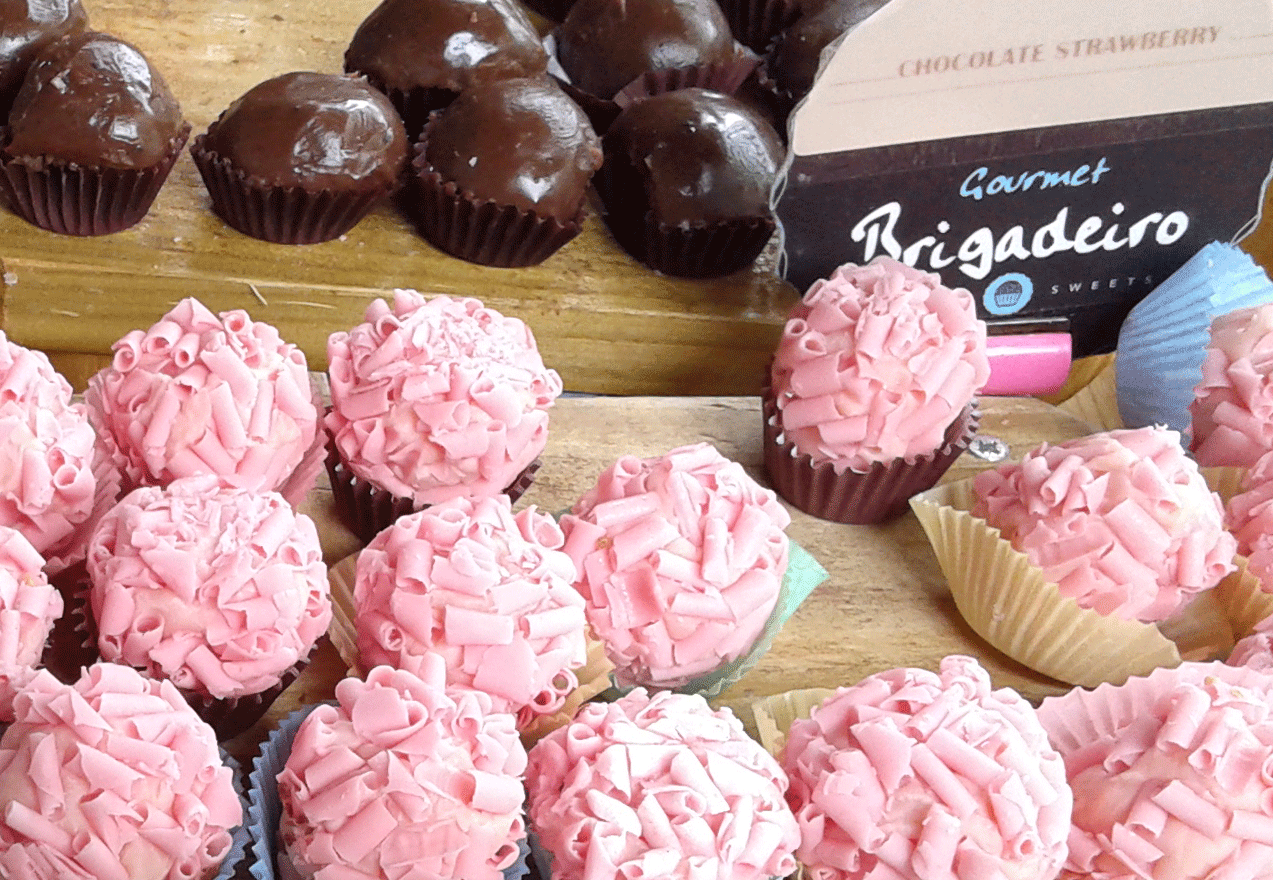
büche de noël FranceA sponge roll cake shaped in the form of a yule log and frosted with buttercream traditional to France for Christmas. The dessert comes out of a seasonal French ritual in which a large log is set into the fireplace for the holiday. The cake seems to have been invented in the later part of the nineteenth century. The recipe appears in print for the first time in the 1890s. Initially it used to be made with a moka buttercream however contemporary cakes are often iced with a chocolate frosting among many other variations.
.jpg?crc=90711394)
bûche de noël in Pierre Lacam’s, Le mémorial historique et géographique de la pâtisserie (1898)
buchty Czech Rep., buchteln Austria
Buchty are made by filling an enriched yeast dough with a filling--poppy seed, farmer's cheese and prune butter are typical--and arranging these in a baking pan so that that the resulting pastry has a rectilinear form. Small versions are sometimes baked blind and served with a custard sauce.
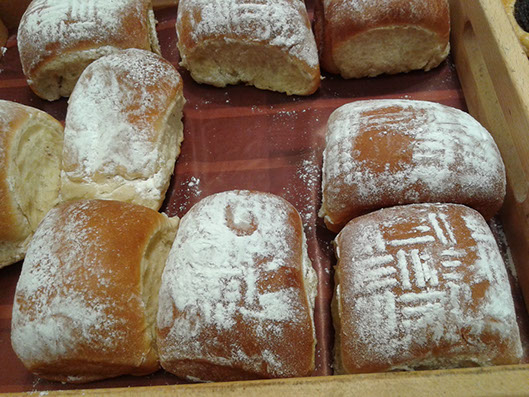
bussolaì Italycoming soon
buttercream U.S., U.K., crème au beurre France, Buttercreme Austria/GermanyButtercream is a rich, butter-based cake frosting or filling. The first buttercream appears to have been created in France as an ingredient for the gâteau moka in the middle years of the 19th century. It was soon adapted by the pastry cooks of Vienna’s empire where it became ubiquitous in Austria’s numberless tortes. There are at least a half dozen ways of making buttercream most of which include egg yolks or egg whites. The so-called Italian buttercream begins by drizzling hot syrup into beaten egg whites while French buttercream uses yolks. Swiss buttercream heats the sugar with the whites. Some Central European recipes call for uncooked egg yolks or a custard base while Americans most commonly use no eggs whatsoever--using just butter and powdered sugar--making for a sweeter, denser version of the recipe.
butter tart CanadaSmall tarts filled with a sugar and (typically) corn syrup filling. Other than the size, these are very similar to American syrup and chess pies.vbrazo gitano Spain, South America
cajeta MexicoSee dulce de leche (below).
canelé Francecoming soon... In the meantime, look at Paula Wolfert’s take on the pastry
cannoli ItalyA Sicilian specialty, consisting of a fried cylinder filled with a sweet-ricotta cream. The dessert probably descends from an medieval Arab recipe. c
charlotte FranceTwo, quite distinct recipes share the same name. In the more rustic version, thin slices of buttered bread are used to line a mold, the center is filled with stewed fruit (most commonly apples) before being baked. It is best served warm. The invention of the charlotte russe (originally named charlotte parisienne) is attributed to Antonin Carême. It too is made in a mold, though in this case the vessel is lined with lady fingers and filled with bavaroise (Bavarian cream) and served cold.
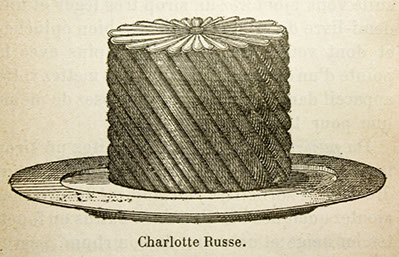
chebbakia, mkharka MoroccoA sesame-encrusted flower-shaped fritter traditional for Ramadan. The pastry is generously flavored with saffron and other spices and coated in honey and sesame seeds after frying. See recipe.
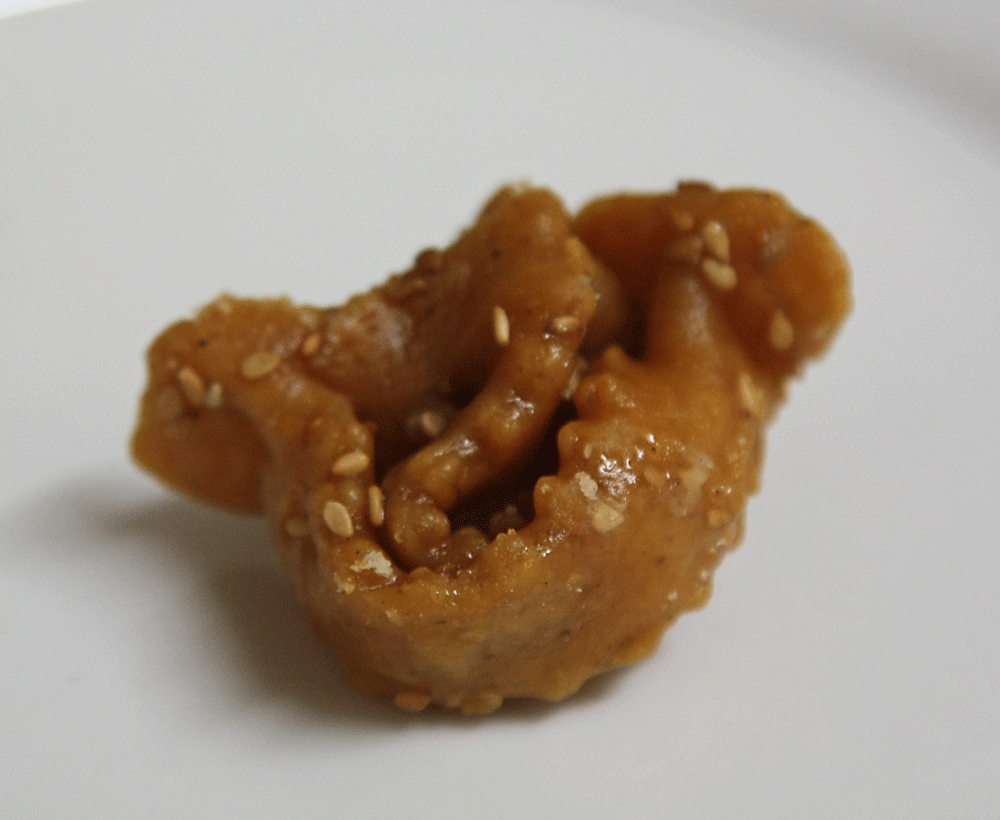
cherries jubilee US, cerises jubilé FrancePitted cherries, either fresh or preserved, are flamed with kirsch as they are being served. Though the recipe is originally French it had a great vogue in the United States in the post WWI era and through the 1950s. Americans typically served the flaming cherries over ice cream. The recipe may originate at the Grand Hotel Monte Carlo; an early recipe attributes it to the hostelry. See The St. James's Cookery Book (1894), p. 154.
chimaki JapanA jelly of kudzu starch wrapped in bamboo grass.
choux à la crème France, profiterole, cream puff US, UKcoming soon...
ciambella, giambella Italy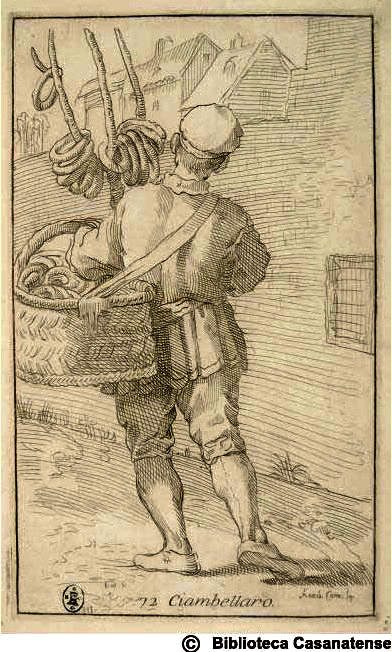 In Italy, ciambella is a term for all sorts of ring-shaped cakes or sweet breads. Some are as large as a bundt cake, others more the size of a doughnut. These days, the word is even used for American-style doughnuts. In one recipe that goes back hundreds of years (Messisbugo refers to them as brazzatelle) a yeast-leavened, lightly sweetened, anise-scented, dough is formed into rings and then boiled before baking (much like a bagel). Today these are now usually called ciambelle scottolate to differentiate them form all those other kinds.
In Italy, ciambella is a term for all sorts of ring-shaped cakes or sweet breads. Some are as large as a bundt cake, others more the size of a doughnut. These days, the word is even used for American-style doughnuts. In one recipe that goes back hundreds of years (Messisbugo refers to them as brazzatelle) a yeast-leavened, lightly sweetened, anise-scented, dough is formed into rings and then boiled before baking (much like a bagel). Today these are now usually called ciambelle scottolate to differentiate them form all those other kinds.
clafouti FranceA dense, crusty custard (or baked pancake) studded with fresh black cherries (classically unpitted) traditional to Limousin.
colomba ItalyA northern Italian specialty traditional for Easter. Made of a rich yeast-leavened dough the cake/bread is made to resemble a dove (colomba in Italian).
cookie US, biscuit UK, France, biscotto ItalyJust about every dessert-loving culture has some sort of small cakes that are eaten by hand. Sweet cookies called biscotti existed in Italy at least as early as the 16th century and various small cakes were popular throughout pre-Revolutionary France as a snack to go with newly popular beverages like hot chocolate, coffee and tea. In the eighteen-hundreds the British pioneered techniques of mass producing “biscuits.” Manufacturers in France, Germany and the United States soon followed suit. The American term “cookie” comes from the Dutch koekje, or “little cake” which is just what the early Dutch colonial treats resembled. In the United States, most cookies resembled rolled sugar cookies until the late 1800s. Drop cookies came into their own around the turn of the twentieth century eventually morphing into such American classics as oatmeal cookies, peanut butter cookies and chocolate chip cookies. (For more on drop cookies see my blog.)
cornes de gazelle MoroccoCrescent-shaped cookies filled with ground almonds and scented with orange flower water and other flavorings. See recipe.
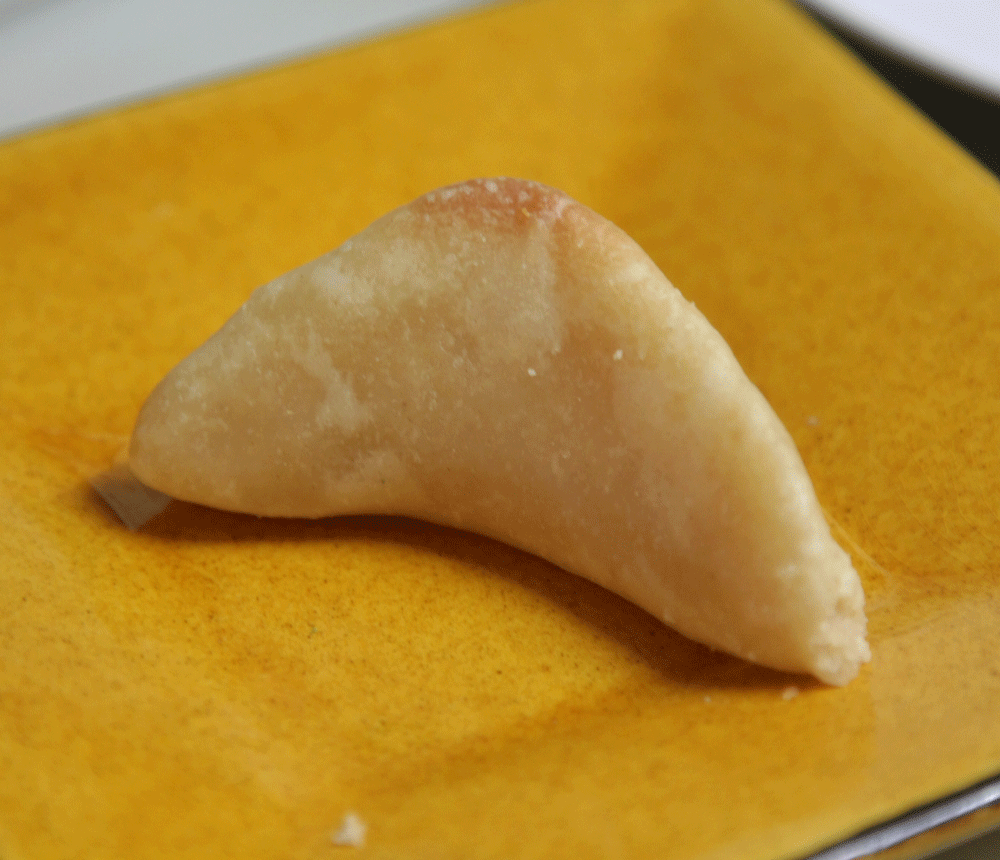
crème brulée France, burnt cream UKA rich custard is topped with a thin layer of sugar that is caramelized just before serving, creating a hard crisp layer that contrasts with the creamy custard beneath. There is some controversy about who first came up with the idea; some writers posit an English origin (I’m skeptical) or an Iberian birthplace (which seems more likely given the Portuguese and Spanish obsession with custard). The first recipe that we know of, however, is in a late seventeenth French cookbook written by François Massialot. (See Le Cuisinier royal et bourgeois, p. 219). If cookbooks are any indication of popularity, the following century saw quite a vogue for crème brûlée in both France and England--where it was known under its literal translation: “burnt cream.” The 1980s saw a huge crème brûlée renaissance in fancy restaurants in the United States and elsewhere.
crêpe France, Palatschinken Austria
Coming soon
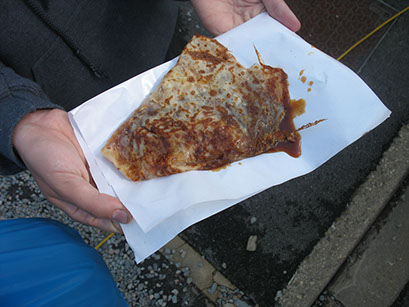
crisp US, crumble UKcoming soon...
cupcake USSmall frosted cakes usually baked in a muffin tin. The “cup” in the name originally referred to the measurement of the ingredients that went into the batter—a cup of butter, two cups sugar, three cups flour, and so on. While in the United States, the current cupcake craze can probably be attributed to the refusal of baby boomers and their offspring to grow up, internationally the culprit is more likely worldwide reruns of “Sex and the City.”
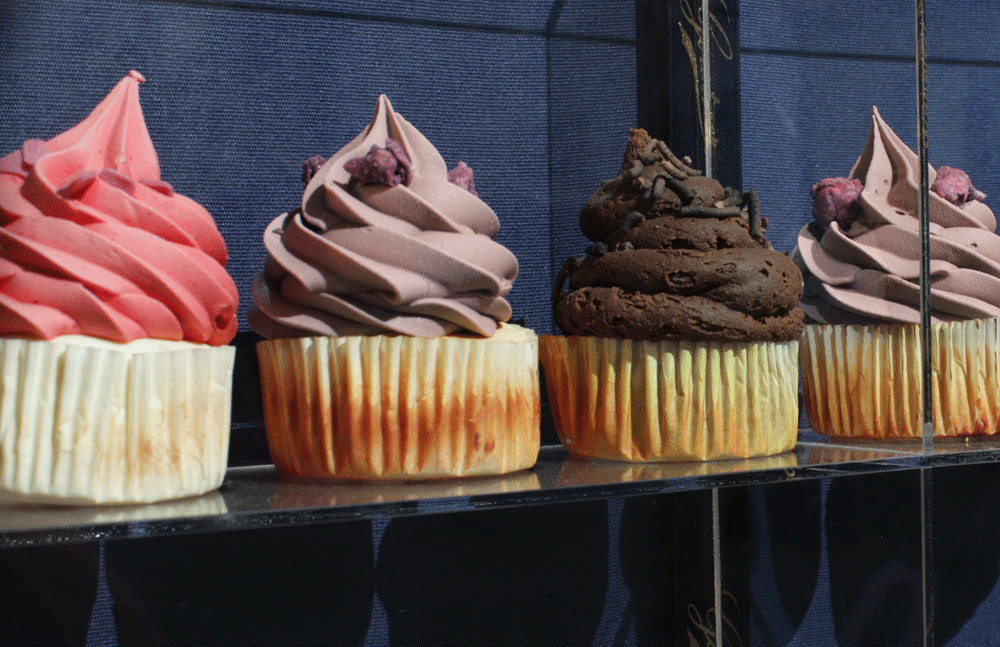
cuzzupa, cucolo ItalyA sweet, egg-enriched bread/cake typical of Easter in Calabria. It takes the form of round braided circle (though other shapes--hearts, birds, fish--are also common) in which one or more eggs is typically embedded.
daifuku JapanA soft round pillow of mochi (rice flour paste) filled with sweetened red or white bean paste. Ichigo daifuku is a whole strawberry wrapped in mochi.
dan tat, dahn taht ChinaSmall custard tarts popular in Cantonese bakeries (tat comes from the English word “tart”). Presumably these were originally adopted and adapted from the similar Portuguese pastéis de nata most likely by way of Macao.
Dampfnudel Austria/BavariaLarge steamed dumplings today typically served with a custard sauce.
devil's food cake UScoming soon...
doberge cake USThe doberge cake is a New Orleans specialty apparently created by Beulah Ledner in the 1930s. The cake is based on the Dobostorte–thus the name–but is made by layering American-style yellow cake with either chocolate or lemon pudding, resulting in a cake than can easily top 6 inches (15 cm) in height. The outside it typically frosted with buttercream. For more on its invention see Carolyn Kolb, “Sweet Story,” New Orleans Magazine (June 2008).
Dobostorte Austria, HungaryThe Dobostorte is made by layering five or more ultra-thin sheets of sponge cake with chocolate buttercream, the whole finished with a mirror-like finish of caramel. The cake is named after Lajos Dobos who created his multistoried extravaganza in the 1880s, presumably basing his cake on the similar and somewhat earlier gâteau moka.
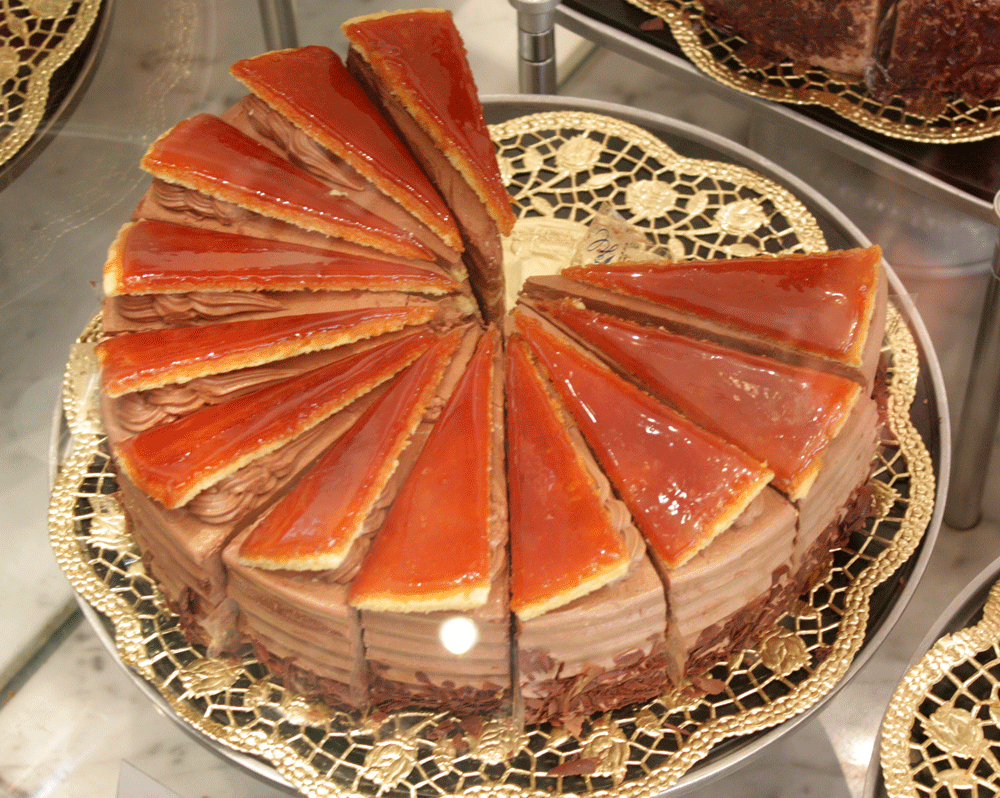
doce de letie da sogra BrazilLiterally, “mother-in-law’s doce de leite,” this is a starch-thickened pudding rather than the caramelized confection familiar to most Latin Americans.
dorayaki JapanTwo small wheat flour pancakes sandwich a filling of red bean paste.
doughnuts US, UK, beignets France, Louisiana (US), Krapfen, Krapfel, Pfannkuchen Austria/Germany koblihy Czech Republic, paczki Poland, frittele, bignè, bomboloni Italy
Doughnuts are probably as old as frying. The ancient Greeks had their doughnuts, as did the Indians and medieval Arabs. Spanish speakers in both the Old World and the New eat several kinds of churros. In Central Europe, filled doughnuts are popular. They have long been associated with Carnival due to the large amount of lard (forbidden during Lent) that used to be needed to fry them properly. Early German recipes for Krapfen date to at least the Middle Ages. Loosely speaking there are three ways to make a ball of fried dough. One of the oldest (there is a recipe for this in the ancient Roman cookbook attributed to Apicius) is to mix hot water and flour and occasionally eggs resulting in a sort of cream-puff dough. Spanish churros and Italian zeppole are made this way. More widespread is the use of a yeast dough. In North America doughnuts are also often made with a chemically leavened dough. This is how the cider doughnut,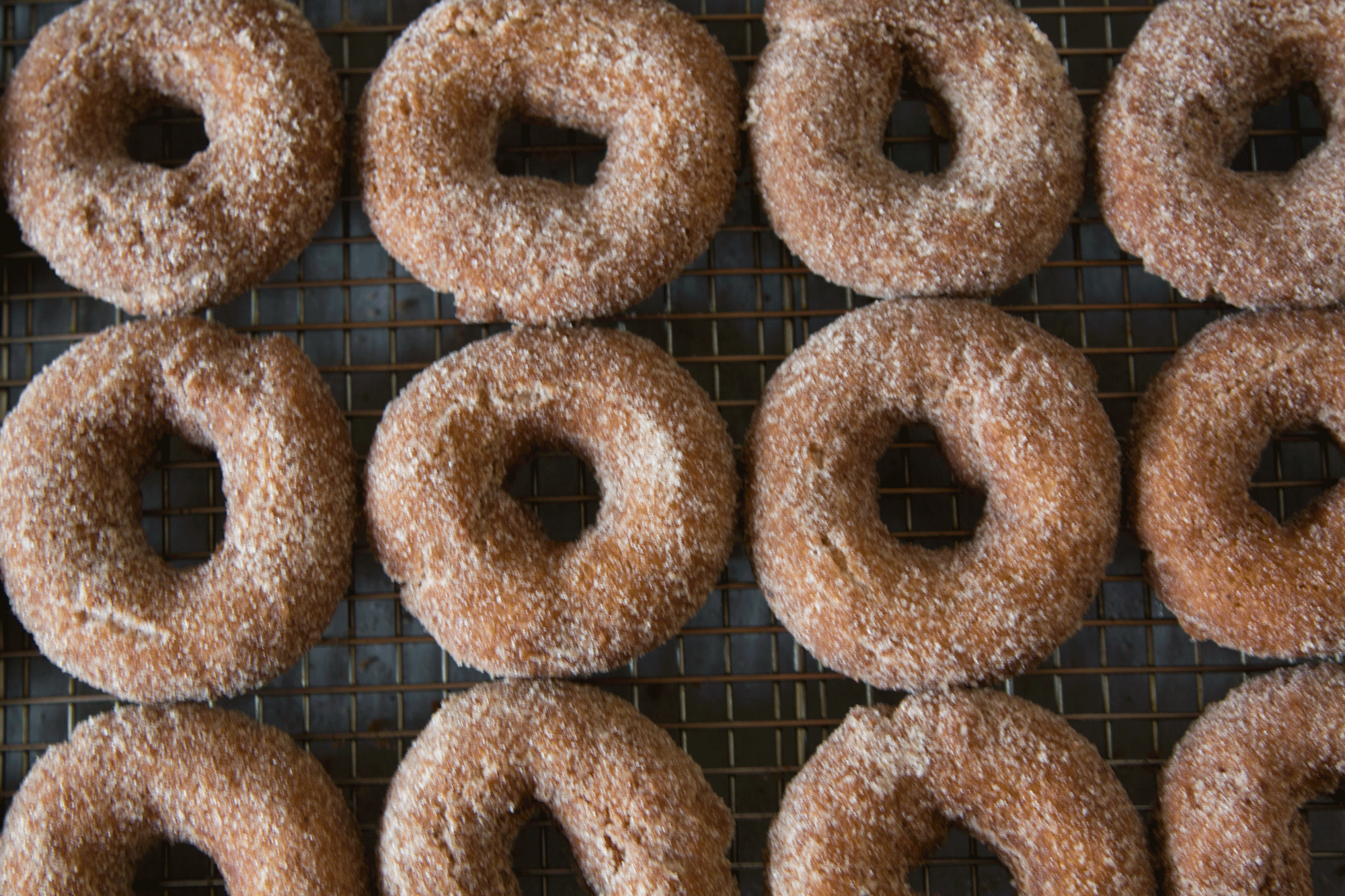 typical of New England, is made as well as many of the varieties on offer at Dunkin’ Donuts. In America it is likely that yeast-leavened doughnuts were brought over to New England by settlers from Herfordshire though the Dutch and Germans certainly brought over their traditions too. The first mention of the typical doughnut shape dates to the Civil War though it may have been around for decades before that. Today, both yeast-leavened and baking-powder- or soda-leavened doughnuts are popular across the United States, some filled with jelly or custard, others in the now-traditional life-saver shape.
typical of New England, is made as well as many of the varieties on offer at Dunkin’ Donuts. In America it is likely that yeast-leavened doughnuts were brought over to New England by settlers from Herfordshire though the Dutch and Germans certainly brought over their traditions too. The first mention of the typical doughnut shape dates to the Civil War though it may have been around for decades before that. Today, both yeast-leavened and baking-powder- or soda-leavened doughnuts are popular across the United States, some filled with jelly or custard, others in the now-traditional life-saver shape.
"dragon's beard" ChinaA candy more than a dessert, this is made of super-thin threads of sugar (thus the dragon’s “beard” or “hair”) wrapped around a filling of peanuts and coconut. Think very dense and chewy cotton candy with a crunchy center. See the recipe on Food.com.
duff US, UK, Canada (mostly 19th century)I quote Sandra Oliver, Saltwater Foodways (1995): “This famous sailor's dish is another whose name comes from northern England. The word comes from 'dough,’ pronounced to rhyme with ‘enough,’ meaning a flour pudding or dumpling." ...Depending on the ratio of flour to water, and length of time it was boiled, a duff could range from soft and pudding-like to almost cake-like inside. It...was served with molasses as sauce. "Plum duff' had raisins in it, which added to the sweetness, but at sea dried apples were used more often than raisins.... The average duff recipe called for flour, shortening, saleratus, raisins or dried fruit (apples), and water. It was boiled in a cloth bag.”
dulce de leche Latin America, doce de leite BrazilDulce de leche is made by cooking down sweetened milk resulting in a thick syrup consistency with a rich caramelized flavor. It is popular throughout Latin America where it is used as a spread, sauce or flavoring for other desserts. While most dulce de leche is made of cow’s milk, the Mexican variation, called cajeta, is more commonly made of goat’s milk.
cajeta Mexico
See dulce de leche (below).
canelé France
coming soon... In the meantime, look at Paula Wolfert’s take on the pastry.
cannoli Italy
A Sicilian speciality, consisting of a fried cylinder filled with a sweet-ricotta cream. The dessert probably descends from an medieval Arab recipe. c
charlotte France
Two, quite distinct recipes share the same name. In the more rustic version, thin slices of buttered bread are used to line a mold, the center is filled with stewed fruit (most commonly apples) before being baked. It is best served warm. The invention of the charlotte russe (originally named charlotte parisienne) is attributed to Antonin Carême. It too is made in a mold, though in this case the vessel is lined with lady fingers and filled with bavaroise (Bavarian cream) and served cold.
chebbakia, mkharka Morocco
A sesame-encrusted flower-shaped fritter traditional for Ramadan. The pastry is generously flavored with saffron and other spices and coated in honey and sesame seeds after frying. See recipe.
cherries jubilee US, cerises jubilé France
Pitted cherries, either fresh or preserved, are flamed with kirsch as they are being served. Though the recipe is originally French it had a great vogue in the United States in the post WWI era and through the 50s. Americans typically served the flaming cherries over ice cream. The recipe may originate at the Grand Hotel Monte Carlo; an early recipe attributes it to the hostelry. See The St. James's Cookery Book (1894), p. 154.
chimaki Japan
A jelly of kudzu starch wrapped in bamboo grass.
choux à la crème France, profiterole, cream puff US, UK
coming soon...
ciambella, giambella Italy
In Italy, ciambella is a term for all sorts of ring-shaped cakes or sweet breads. Some are as large as a bundt cake, others more the size of a doughnut. These days, the word is even used for American-style doughnuts. In one recipe that goes back hundreds of years (Messisbugo refers to them as brazzatelle) a yeast-leavened, lightly sweet-ened, anise-scented, dough is formed into rings and then boiled before baking (much like bagel). These are now usually called ciambelle scottolate to differentiate them form all those other kinds
clafouti France
A dense, crusty custard (or baked pancake) studded with fresh black cherries (classically unpitted) traditional to Limousin.
colomba Italy
A northern Italian specialty traditional for Easter. Made of a rich yeast-leavened dough the cake/bread is made to resemble a dove (colomba in Italian).
cookie United States, biscuit United Kingdom, France, biscotto Italy
Just about every dessert-loving culture has some sort of small cakes that are eaten by hand. Sweet cookies called biscotti existed in Italy at least as early as the 16th century and various small cakes were popular throughout pre-Revolutionary France as a snack to go with newly popular beverages like hot chocolate, coffee and tea. In the eighteen-hundreds the British pioneered techniques of mass producing “biscuits.” Manufacturers in France, Germany and the United States soon followed suit. The American term “cookie” comes from the Dutch koekje, or “little cake” which is just what the early Dutch colonial treats resembled. In the United States, most cookies resembled rolled sugar cookies until the late 1800s. Drop cookies came into their own around the turn of the twentieth century eventually morphing into such American classics as oatmeal cookies, peanut butter cookies and chocolate chip cookies. (For more on drop cookies see my blog.)
cornes de gazelle Morocco
Crescent-shaped cookies filled with ground almonds and scented with orange flower water and other flavorings. See recipe.
crème brûlée France, burnt cream UK
A rich custard is topped with a thin layer of sugar that is caramelized just before serving, creating a hard crisp layer that contrasts with the creamy custard beneath. There is some controversy about who first came up with the idea; some writers posit an English origin (I’m skeptical) or an Iberian birthplace (which seems more likely given the Portuguese and Spanish obsession with custard). The first recipe that we know of, however, is in a late seventeenth French cookbook written by François Massialot. (See Le Cuisinier royal et bourgeois, p. 219). If cookbooks are any indication of popularity, the following century saw quite a vogue for crème brûlée in both France and England--where it was known under its literal translation: “burnt cream.” The 1980s saw a huge crème brûlée renaissance in fancy restaurants in the United States and elsewhere.
crisp US, crumble UK
coming soon...
cupcake United States
Small frosted cakes usually baked in a muffin tin. The “cup” in the name originally referred to the measurement of the ingredients that went into the batter—a cup of butter, two cups sugar, three cups flour, and so on. While in the United States, the current cupcake craze can probably be attributed to the refusal of baby boomers and their offspring to grow up, internationally the culprit is more likely worldwide reruns of “Sex and the City.”b
cuzzupa, cucolo Italy
A sweet, egg-enriched bread/cake typical of Easter in Calabria. It takes the form of a round braided circle (though other shapes--hearts, birds, fish--are also common) in which one or more eggs is typically embedded.
daifuku Japan
A soft round pillow of mochi (rice flour paste) filled with sweetened red or white bean paste. Ichigo daifuku is a whole strawberry wrapped in mochi. daifuku
dan tat, dahn taht China
Small custard tarts popular in Cantonese bakeries (tat comes from the English word “tart”). Presumably these were originally adopted and adapted from the similar Portuguese pastéis de nata most likely by way of Macao.
Dampfnudel Austria/Bavaria
Large steamed dumplings today typically served with a custard sauce.
devil’s food cake US
coming soon...
Da
doberge cake US
The doberge cake is a New Orleans specialty apparently created by Beulah Ledner in the 1930s. The cake is based on the Dobostorte–thus the name–but is made by layering American-style yellow cake with either chocolate or lemon pudding, resulting in a cake than can easily top 6 inches (15 cm) in height. The outside it typically frosted with buttercream. For more on its invention see Carolyn Kolb, “Sweet Story,” New Orleans Magazine (June 2008).
Dobostorte Austria, Hungary
The Dobostorte is made by layering five or more ultra-thin sheets of sponge cake with chocolate buttercream, the whole finished with a mirror-like finish of caramel. The cake is named after Lajos Dobos who created his multistoried extravaganza in the 1880s, presumably basing his cake on the somewhat earlier gâteau moka.
doce de leite da sogra Brazil
Literally, “mother-in-law’s doce de leite,” this is a starch-thickened pudding rather than the caramelized confection familiar to most Latin Americans.
dorayaki Japan
Two small wheat flour pancakes sandwich a filling of red bean paste. dorayaki
doughnuts United States, beignets France, Louisiana (US), Krapfen Krapfel, Austria/Germany koblihy Czech Republic, paczki Poland, frittele, bignè, bomboloni Italy
Doughnuts are probably as old as frying. The ancient Greeks had their doughnuts, as did the Indians and
medieval Arabs. Spanish speakers in both the Old World and the New eat several kinds of churros. In Central Europe, filled doughnuts are popular. They have long been associated with Carnival due to the large amount of lard (forbidden during Lent) that used to be needed to fry them properly. Early German recipes for Krapfen date to at least the Middle Ages. Loosely speaking there are three ways to make a ball of fried dough. One of the oldest (there is a recipe for this in the ancient Roman cookbook attributed to Apicius) is to mix hot water and flour and occasionally eggs resulting in a sort of cream-puff dough. Spanish churros and Italian zeppole are made this way. More widespread is the use of a yeast dough. In North America doughnuts are also often made with a chemically leavened dough. This is how the cider doughnut, typical of New England, is made as
well as many of the varieties on offer at Dunkin’ Donuts. In America there is some evidence that yeast-leavened doughnuts were brought over to New England by settlers from Herfordshire though the Dutch and Germans certainly brough over their traditions too. The first mention of the typical doughnut shape dates to the Civil War though it may have been around for decades before that. Today, both yeast-leavened and baking-powder- or soda-leavened doughnuts are popular across the United States, some filled with jelly or custard, others in the now-traditional life-saver shape.
“dragon‘s beard” China
A candy more than a dessert, this is made of super-thin threads of sugar (thus the dragon’s “beard” or “hair”) wrapped around a filling of peanuts and coconut. Think very dense and chewy cotton candy with a crunchy center. See the recipe on Food.com.
duff US, UK, Canada (mostly 19th century)
I quote Sandra Oliver, Saltwater Foodways (1995): “This famous sailor's dish is another whose name comes from northern England. The word comes from 'dough,’ pronounced to rhyme with ‘enough,’ meaning a flour pudding or dumpling." ...Depending on the ratio of flour to water, and length of time it was boiled, a duff could range from soft and pudding-like to almost cake-like inside. It...was served with mollasses as sauce. "Plum duff' had raisins in it, which added to the sweetness, but at sea dried apples were used more often than raisins.... The average duff recipe called for flour, shortening, saleratus, raisins or dried fruit (apples), and water. It was boiled in a cloth bag.”
dulce de leche Latin America, doce de leite Brazil
Dulce de leche is made by cooking down sweetened milk resulting in a thick syrupy consistency with a rich caramelized flavor. It is popular throughout Latin America where it is used as a spread, sauce or flavoring for other desserts. While most dulce de leche is made of cow’s milk, the Mexican variation, called cajeta, is more commonly made of goat’s milk.
éclair FranceAn individual-sized dessert made with cream puff pastry (pâte à choux), most commonly filled with pastry cream and topped with one of several types of glaze (chocolate and caramel are the most typical). Éclairs are usually the shape and size of a very small hot-dog bun. More recently, some pastry chefs have begun to experiment with less common flavors, such as Elizabeth Falkner’s cassis-violet and raspberry-rose flavored éclairs pictured below.

Election Cake US (18th-19th centuries)In the early years of the United States, these huge cakes were baked for special occasions such as elections. The usual recipe resembled what we now call a fruitcake. For the earliest printed recipe in an American cookbook (these sorts of “great cakes” were common enough in England), see Amelia Simmons’ American Cookery (1796), p. 43.
entremets FranceThe term, entremets, roughly follows the development of the French menu. Pre-Revolutionary menus took the form of several courses where numerous dishes were served buffet-style–the so-called “service à la française.” The sequential service common today, referred to as “service à la russe,” was introduced in the 19th century. Under the old way of serving, entremets were literally what was placed “entre les mets,” that is between the main dishes. The entremets were often pastries both sweet and savory, but they could also include vegetables. (In the late 1600s “hors d’oeuvres” meant roughly the same thing.) By the late nineteenth century the term entremets became more restrictive and started to refer to an exclusively sweet course to be served after the cheese course. The 1961 Larousse Gastronomique uses entremets as a synonym for dessert. More recently (since the 1990s?) entremet (without the “s”) has come to mean a cake made up of layers of sponge cake and mousse. This use is especially common in the United States but French pastry chefs also use it.
Eton mess UK
A thoroughly delicious but utterly unkempt British dessert (a.k.a. "pudding") consisting of crumbled hard meringues, whipped cream (occasionally ice cream) and fruit, most typically strawberries, though contemporary versions may include many other types of fruit. Historian Arthur Beavan records that the unruly dessert was apparently served at a 1893 house party to Queen Victoria, the rest of menu is here. He does not mention if she was amused.
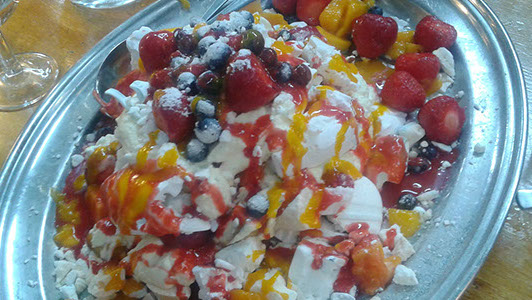
fairy cake UKcoming soon
far breton FranceA dense, crusty custard or baked pancake typical of Brittany. It is similar to clafouti though here dried prunes take the place of fresh cherries.
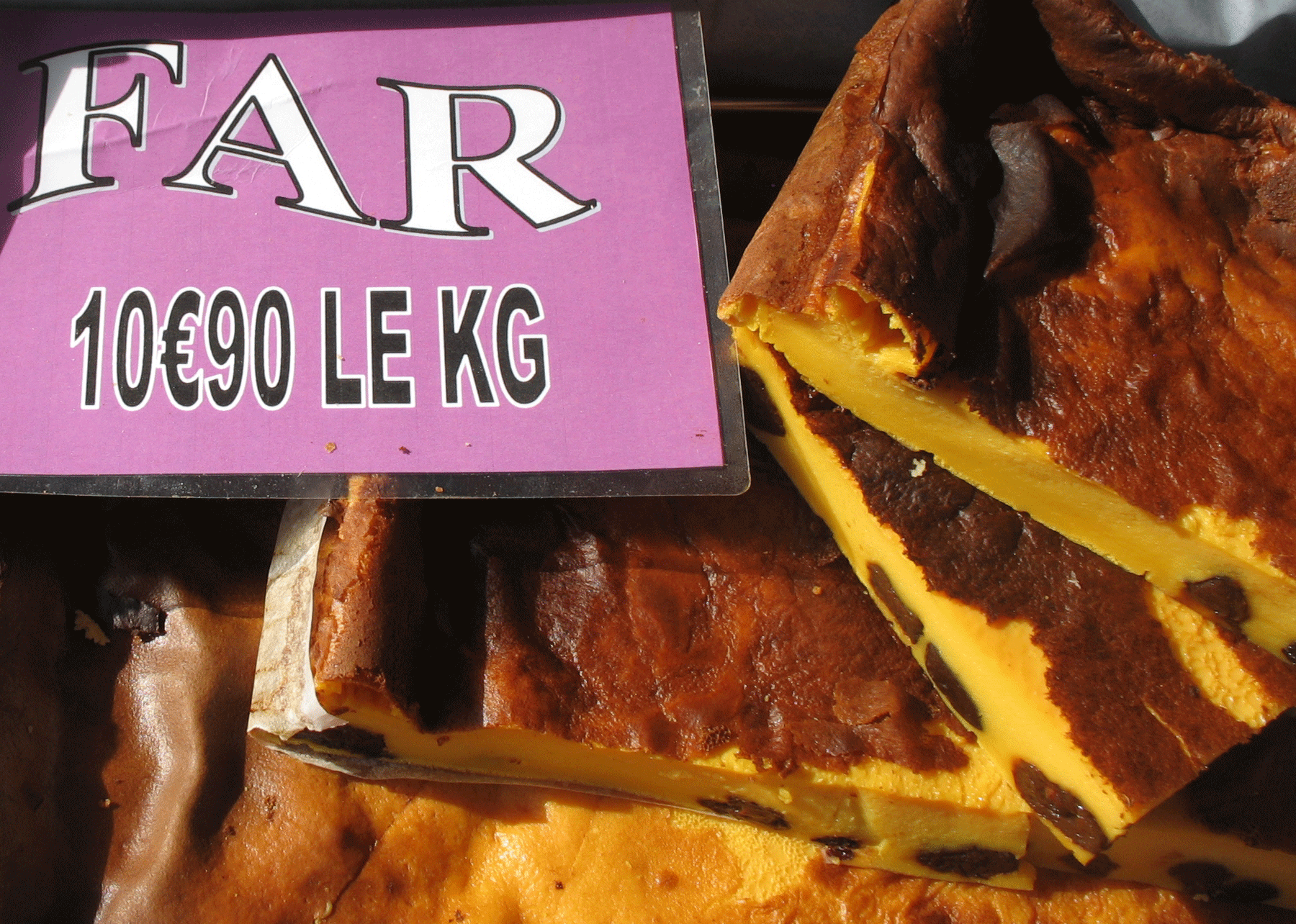
fastnachts United StatesPlain yeast-based doughnuts associated with the Pennsylvania Dutch (Germans). They are traditional to Shrove Tuesday (Fastnacht in German). Many recipes include mashed potatoes and occasionally replace the yeast with baking powder. See also doughnuts.
figgy duff Newfoundland (Canada), UKIn Newfoundland, a figgy duff is a boiled pudding made with raisins, sweet spices and molasses. The terms comes from the UK where it was dialect for fig pudding though (at least in Cornwall) there also used to be a baked cake of the same name.
filo (also phyllo) Greece, yufka TurkeyPaper-thin sheets of wheat-based dough. Unlike strudel dough, the pastry is not stretched but rather made by rolling the dough very thin, traditionally several layers at a time, with starch to keep them separated. These sheets are then typically brushed with fat and layered once more before baking. See Gulluoglu video.
fios de ovos PortugalThis quintessentially Portuguese confection is made by drizzling a batter of egg yolks into boiling syrup. The result looks like a tangle of yellow vermicelli and has a chewy, almost rubbery texture. These are most often used as an ingredient in other desserts.
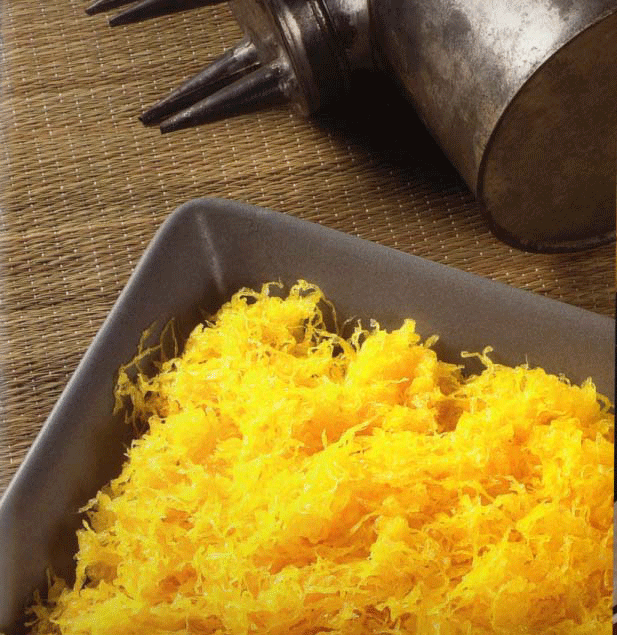
Photo: Antonio Rosado from Doçaria Popular Portuguesa, 2004
financier Francecoming soon...
flan FranceA single crust tart that may be filled with either sweet or savory preparations. While this is the most general meaning in French, it can occasionally also refer to set custards as in Spain; see below.
flan Spain, Latin America, pudím Portugal, crème caramel FranceAn egg-rich custard that is baked on top of a layer of caramelized sugar. When unmolded the sugar forms a caramel-flavored sauce.
floating island UK, île flottante, oeufs à la neige FranceMost commonly this is a dessert made by poaching meringues in sweetened milk and serving them with crème anglaise (vanilla custard sauce). The 1961 edition of Larousse Gastronomique describes an île flottante as a sponge cake, cut in layers, soaked in kirsch and maraschino, reassembled, iced with crème chantilly (sweetened whipped cream) and served in a pool of crème anglaise while the meringue version is identified as oeufs à la neige. Both versions of the recipe show up earlier in English rather than French sources.
fried pie USEssentially a fried turnover that uses the same ingredients as a classic American fruit-filled pie. These days, it’s mostly associated with the South; Leslie Brenner, the Dallas News restaurant critic tells me this one needs a pronouncer: “fraaahd paaah.” That said, Yankees have a long tradition of fried pies too. Yankee Notions, a collection of New England lore from 1852, gives a recipe for a nightmare that includes a fried pie as an ingredient:
“Just before going to bed, eat two pig’s feet and a fried pie. In less than an hour you will see a snake larger that a hawser devouring eight blue-haired children who have just escaped from a monster with sorrel eyes and a red-hot overcoat.” (p. 120)
fritelle veneziane ItalyEgg-sized doughnuts made from a yeast dough scattered with candied fruit and spiked with a shot of grappa or anisette.
ganache FranceA mixture of cream and chocolate used as a base for chocolate candy such as truffles or as a frosting for cakes and other pastries. In some cases the cooled mixture is beaten to lighten it. In Austria, this whipped ganache is referred to as Pariser Creme.
gâteau France"Gâteau” is most commonly translated as cake but the term means both more and less than this. There are gâteaux that do indeed resemble what English-speakers would recognize as a cake, but others are more like a complex pastry, see for example the gâteau Saint-Honoré (below). A petit gâteau might well be a small cake such as a madeleine but it is equally likely to be a cookie, or in contemporary usage, even a muffin or cupcake.
gâteau basque Francecoming soon...
gâteau moka FranceA multi-layered cake made with very thin layers of vanilla sponge and coffee-flavored buttercream. According to the nineteenth century pastry authority Pierre Lacam, the cake was invented by a pastry cook by the name of Guignard in 1857.
gâteau Saint-Honoré FranceA crown-like pastry creation made by piping pâte à choux around the circumference of a round of tart pastry. Once baked the cream puffs are partially coated with caramel and the center filled with crème Chiboust (custard lightened with meringue) or more commonly, custard lightened with whipped cream.
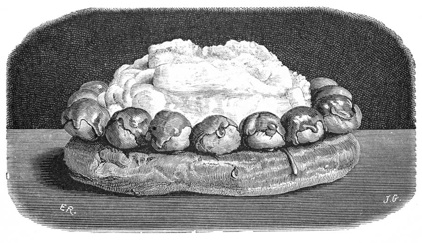
The invention of the cake is widely credited to the Julien brothers who ran a pastry shop in Paris in the first part of the nineteenth century. It’s worth noting that early versions of the gâteau Saint-Honoré were occasionally made with brioche, some were filled with whipped cream only, and others with a Bavarian cream (set with gelatin).
génoise FranceFrench term for sponge cake. The term génoise, in the contemporary sense of a light sponge cake, only dates to the later part of the nineteenth century. Incidentally, it’s unlikely that the French term has anything much to do with Genoa as the name might initially suggest. Rather, the term more probably comes from cakes named after Saint Geneviève.
gingerbread UK, US, pain d’épice France, Lebkuchen Austria/Germany, speculaas NetherlandsThere are generally two forms of gingerbread, one in the form of a cake–usually leavened with baking powder/soda–and the other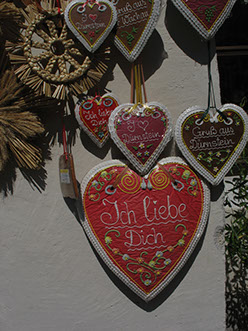 more of a dense cookie dough, which is often pressed into molds. American and English recipes often include molasses while German ones tend to use honey (and don’t always include ginger among the spices). The idea of making molded or shaped honey cakes goes back at least as far ancient Roman times but just when spiced honey cakes traveled to northern Europe is unclear. According to one theory, returning Crusaders brought them home from the Holy Land. In central Europe they have long been associated with holidays and were often brought back from religious fairs as a sort of memento. These days they are more likely to carry banal expressions of affection.
more of a dense cookie dough, which is often pressed into molds. American and English recipes often include molasses while German ones tend to use honey (and don’t always include ginger among the spices). The idea of making molded or shaped honey cakes goes back at least as far ancient Roman times but just when spiced honey cakes traveled to northern Europe is unclear. According to one theory, returning Crusaders brought them home from the Holy Land. In central Europe they have long been associated with holidays and were often brought back from religious fairs as a sort of memento. These days they are more likely to carry banal expressions of affection.
gulab jamun South Asia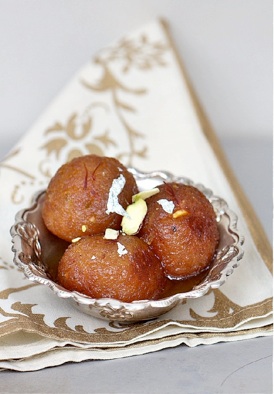 The popular gulab jamun is a syrup-soaked fritter about the size of a Ping-Pong ball. It is very similar in appearance to a fritter made in the Middle East under the name luqmat al qadi. It is likely that they both developed from an earlier Persian antecedent. Gulab comes from the Persian word for rosewater, while jamun refers to a local fruit of roughly this size. The two batters are made entirely differently, though, so the only Persian connection may be the common use of rosewater syrup. Gulab jamun is made by making a batter of mawa (evaporated milk), flour and milk or cream. Balls of this batter are deep fried then soaked in a rosewater-scented sugar syrup. The confection is part doughnut, part baba rum with a pleasantly bitter edge from the twice-caramelized milk sugars. Photo: Deeba Rajpal
The popular gulab jamun is a syrup-soaked fritter about the size of a Ping-Pong ball. It is very similar in appearance to a fritter made in the Middle East under the name luqmat al qadi. It is likely that they both developed from an earlier Persian antecedent. Gulab comes from the Persian word for rosewater, while jamun refers to a local fruit of roughly this size. The two batters are made entirely differently, though, so the only Persian connection may be the common use of rosewater syrup. Gulab jamun is made by making a batter of mawa (evaporated milk), flour and milk or cream. Balls of this batter are deep fried then soaked in a rosewater-scented sugar syrup. The confection is part doughnut, part baba rum with a pleasantly bitter edge from the twice-caramelized milk sugars. Photo: Deeba Rajpal
güllaç TurkeyA pudding-like dessert made by layering gauze-like sheets of starch wafer with nuts and milk. In Ottoman days, güllaç used to be made from egg whites and wheat starch in almost the same way as medieval Arab/Persian lauzīnaj. Today, the sheets are often made with cornstarch and people buy them already cooked, though they will typically finish the dessert at home by soaking these with hot milk and nuts.
halva (also halvah & halwa) Middle East/South AsiaTwo, quite different, confections exist under the name of halva. In the Middle East the most common type is a sort of crumbly nougat made by stirring ground sesame into a sugar syrup. A much older recipe that tends to be more popular in Iran and South Asia is made by frying semolina flour in ghee and then adding hot sugar syrup resulting in a texture closer to fudge. In India, numerous variations exist, among the more popular are gajar halwa, made by cooking down carrots milk before adding the ghee, and moong dal halwa made with mung bean flour and milk.
hamentashen US, Israelcoming soon
hanabira mochi Japan”Flower petal rice cakes” sold at the New Year and highly desired by practitioners of the Japanese tea ceremony.
Hobelspänen Austria/GermanyFritters that are made by wrapping a rod with strips of short pastry dough. These are fried, resulting in curled, ribbon-like fritters. For a recipe see Ch. Kraft, Illustriertes Muster-Kochbuch für einfache und feine Küche (1899), 559.
hot cross buns UKSweet spiced yeast buns flavored with candied fruit and decorated with a cross (usually made of a sugar glaze) traditional for Good Friday in Britain. They are now available throughout the Lenten season. They have been common since at least the 18th century. The first reference I have been able to find is in The Connoisseur (1755). The author, who styles himself “Mr. Town,” writes “We are to have a grand route [party] here upon Good-Friday; and I would advise you to get down into the kitchen among the maids, where you may shew [sic] your regard for the day, by feasting them with Bohea [black tea] of six shillings a pound and hot cross buns.” (360) The cross made with white icing seems to be an American idea.
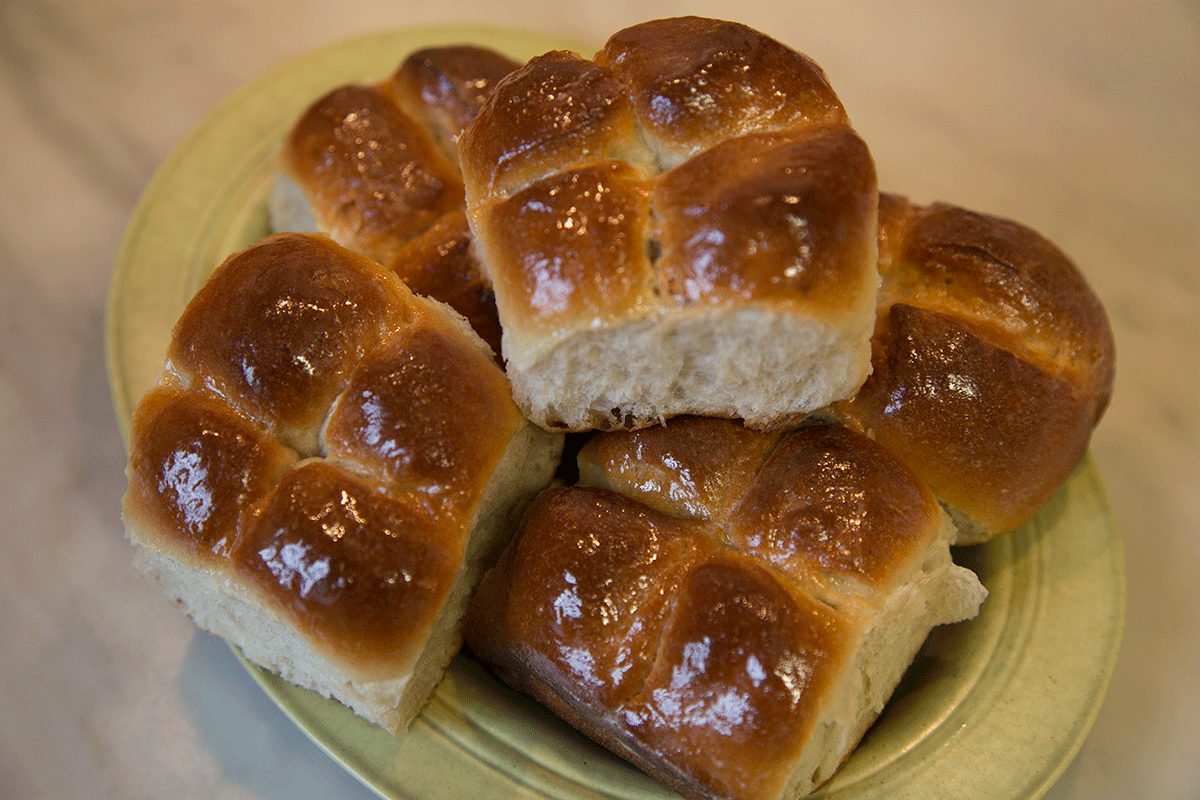
iceSee sorbet.
ice cream UK, US, crème glacé France, gelato Italy, Eis Germany, Gefrorenes Austria (dated)Ice cream is made more or less two ways, either with mixture of cream and eggs or just cream itself. Most likely, the dessert as we know it was first developed in Italy in the 1600s when Italian confectioners discovered that if you placed a sweetened liquid in a tub of ice and salt and kept mixing it, you’d get a delicious spoonable dessert (see illustration). By the end of the century the secret was out as ice cream makers across Europe took the concept and ran with it. Today, there’s hardly a country that doesn’t have some version of ice cream. See also kulfi.
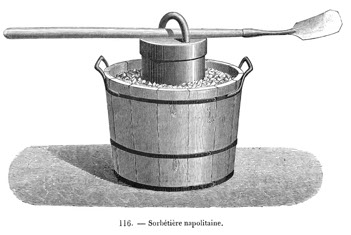
jaggery India, rapadura Brazil, panela Colombia, piloncillo MexicoRaw sugar made by boiling down sugar cane until it forms a solid or semisolid dark brown mass. A similar product is made by boiling down the liquid from certain types of palm.
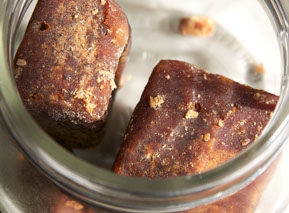
jalebi (also jilebi) South AsiaTo make these violently colored strands of dough confectioners drizzle a thin batter through a hole in a coconut (or more commonly a purpose-built vessel) into hot fat. Once crispy these are then dipped into a sugar syrup. Jalebi batter can be made with bean flour (urad dal), chickpea flour or even wheat flour. The dessert seems to originate in Persia where a similar dessert called zalibīya is popular.
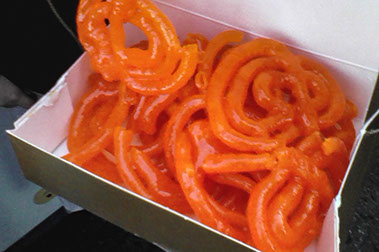
Jell-O USA fruit-flavored, gelatin-based dessert mix first devised and named Jell-O by May Davis Wait in 1897.
kanom foy fong ThailandStrands of sugary egg yolk cooked in syrup. Essentially the same dessert as the Portuguese fios de ovos (see entry) from whom they are adapted. The dessert is typically scented with rose water or jasmine flower essence.
kasutera also castella JapanA spongecake made with whole eggs, flour, sugar and honey. The technique for making the cake was almost certainly introduced into Japan by the Portuguese in the later part of the 16th century (a recipe appears in the early 17th-century Southern Barbarians’ Cookbook, see p. 96.) The name stems also stems from the Portuguese paõ de Castella, or “bread of Castille.”
keiran somen JapanThe Japanese take on fios de ovos. Like kasutera, a recipe first appears in the early 17th-century Southern Barbarians’ Cookbook.
Key lime pie USA custard pie made with the small, flavorful limes common to southern Florida and most of Latin America. The crust is typically made with crushed graham crackers and the filling often includes condensed milk. The pie most likely originated in the early part of the 20th century in the Florida Keys.
khanom chan bi tuey ThailandA thick pudding made with bean flour, cassava starch, tapioca flour and coconut milk. It is flavored with bi tuey, a sweet reed with a bubblegum-like flavor.
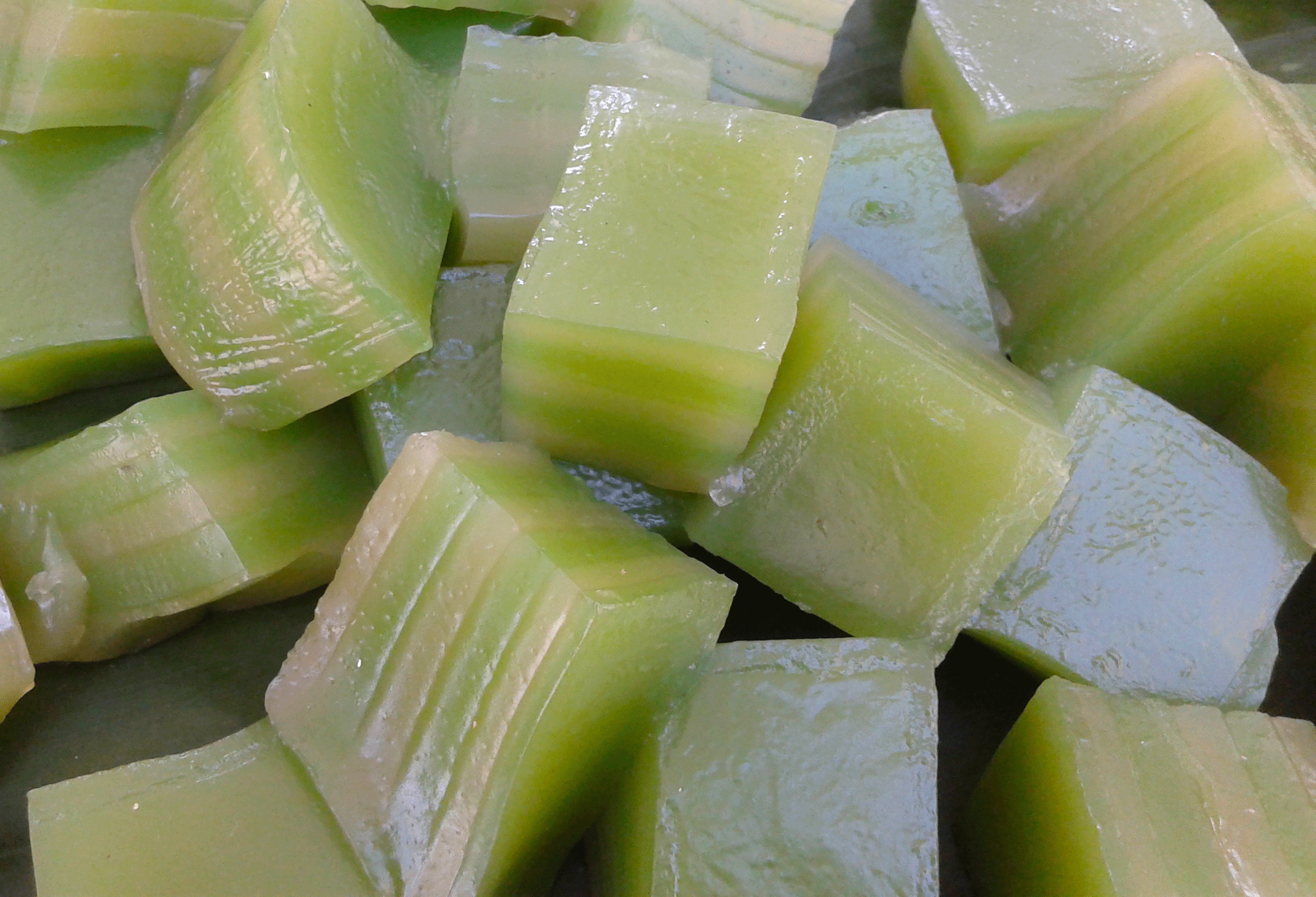
khao niaow ma muang Thailandcoming soon...
kheer, payasam Indiacoming soon
konpeito JapanBumpy sugar ball candy. From the Portuguese word confeito.
kouign amann FranceA pastry (“butter cake” in the local Celtic language) traditional to Brittany made by folding butter and sugar between sheets of puff pastry, then baking it until it caramelizes into a crisp, buttery disk. The result is vaguely reminiscent of sticky buns, though butterier and less messy. They come in sizes from mini (about 3 in/8 cm) like the ones in the photo to large (10 in/25 cm) disks that will serve 8. Nowadays, a filling (raspberry is popular) is often enclosed by the layers.
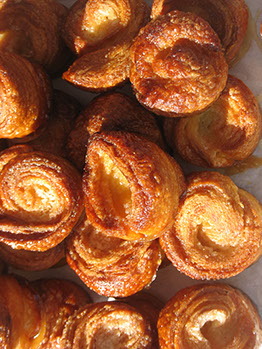
Kugelhupf (also Gugelhupf) Germany/Austria, kouglof (also kougelhopf and suglhupf) France, babka Poland, bábovka Czech Republic, bundt cake US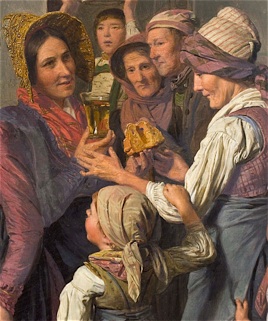 A sweet yeast bread or cake popular across Central Europe and parts of the United States. The earliest recipes are German. (See, for example Freywillig auf-gesprungener Granat-Apffel des christlichen Samariters [1731] 524.) The name (gugel, bonnet and hupf, leap) may be derived from the shape of the molds, which resembled a medieval hat and the action of the yeast dough in the mold. Today, decorative ring-molds are more common; bundt cake means “circle cake.” Early versions were either made with yeast or leavened by extended beating of eggs. With the introduction of chemical leavening in the nineteenth century, it became more common to use baking powder in the batter, though yeast-leavened versions still exist, most notably in Alsace.
A sweet yeast bread or cake popular across Central Europe and parts of the United States. The earliest recipes are German. (See, for example Freywillig auf-gesprungener Granat-Apffel des christlichen Samariters [1731] 524.) The name (gugel, bonnet and hupf, leap) may be derived from the shape of the molds, which resembled a medieval hat and the action of the yeast dough in the mold. Today, decorative ring-molds are more common; bundt cake means “circle cake.” Early versions were either made with yeast or leavened by extended beating of eggs. With the introduction of chemical leavening in the nineteenth century, it became more common to use baking powder in the batter, though yeast-leavened versions still exist, most notably in Alsace.
kulfi, qulfi South AsiaSouth Asia’s answer to ice cream, kulfi is made by filling a conical mold (from which it gets its name) with flavored, sweetened evaporated milk. It is not churned during freezing, unlike ice cream. According to K.T. Achaya’s Dictionary of Indian Food (132) the dessert was either brought by the Mughals from Central Asia or possibly developed by them in Delhi. Again according to Achaya, a description of the dessert appears in the Ain-i-Akbari (1590 CE). If that is the case, the English translations do not include it. For an updated recipe see Deeba Rajpal’s blog.
kuzukiri JapanA clear, noodle-like jelly make from the root of the kudzu plant (Pueraria lobata).
laddu (also laddoo) South Asia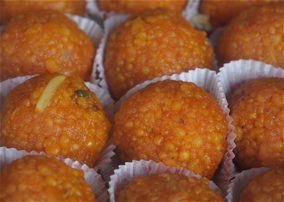 To make this most ubiquitous of the subcontinent’s desserts you take a thinnish batter (typically based on chickpea flour though there are variations that use sesame or semolina) and deep-fry it in hot butter in the form of little drops. These drops, now looking a little like corn kernels, are then soaked in saffron-tinted sugar syrup. This is referred to as bonde. When you form it into two-bite-sized balls it is called a laddu.
To make this most ubiquitous of the subcontinent’s desserts you take a thinnish batter (typically based on chickpea flour though there are variations that use sesame or semolina) and deep-fry it in hot butter in the form of little drops. These drops, now looking a little like corn kernels, are then soaked in saffron-tinted sugar syrup. This is referred to as bonde. When you form it into two-bite-sized balls it is called a laddu.
ladyfingers UK, US, sponge-fingers UK, savoiardi Italy, biscuits à la cuiller France, Biskotten Austria, Loffelbiskuit GermanyElongated (i.e. finger-shaped) sponge-cake-based cookies often used in recipes for charlottes and tiramisù. While the term ladyfinger is relatively recent (1802 according to the OED) these sorts of finger cakes have existed at least since the 17th century and presumably first originated in the Kingdom of Savoy since the French, like the Italians, call a closely related cookie a biscuit de Savoie. That said, early Italian recipes for savoiardi were more like what we call biscotti today, see illustration of the cookie on the left.
Lady Baltimore cake USA rich, white, chemically leavened cake that includes nuts and dried fruit in either the cake itself or more commonly in its filling/icing. This Southern specialty became popular around the turn of the 20th century. The Country Gentleman (22 September, 1910), 895, gives a lovely and exhaustive description of it. The name most likely does not refer to any specific lady but rather to a “lady cake” that happens to be from Baltimore.
Lamington AustraliaA down-under specialty for which sponge cake is dipped in chocolate and rolled in shredded coconut.
lauzīnaj medieval Middle Eastcoming soon...
lemon meringue pie UScoming soon...
Linzerteig AustriaLinzer dough: a rich buttery dough traditionally made with flour, butter, egg and almonds though contemporary recipes sometimes use hazelnuts instead. This was long the basis of Linzertortes (see below) but today is often used to make rolled “Linzer” cookies which may or may not be filled jam.
Linzertorte Austria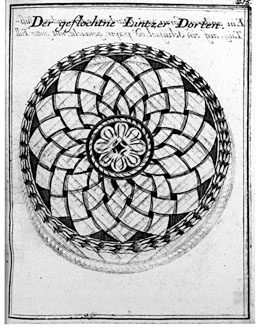 The Linzertorte has a long storied history that goes back to at least 1653. The illustration on the left comes from the Conrad’s Hagger’s magnificent Neues saltzburgisches Koch‐Buch (1719). In com-mon English usage, most people would describe it as a tart rather than a cake. Up until the nineteenth century it was made exclusively with an almond and flour dough enriched with butter, then spread with jam (raspberry or red currant were most typical) and a lattice crust. Contemporary recipes often call for hazelnuts.
The Linzertorte has a long storied history that goes back to at least 1653. The illustration on the left comes from the Conrad’s Hagger’s magnificent Neues saltzburgisches Koch‐Buch (1719). In com-mon English usage, most people would describe it as a tart rather than a cake. Up until the nineteenth century it was made exclusively with an almond and flour dough enriched with butter, then spread with jam (raspberry or red currant were most typical) and a lattice crust. Contemporary recipes often call for hazelnuts.
look choup Thailand
These miniature fruits are made with yellow bean paste made with coconut milk and sweetened with sugar. They are dipped in a glaze based on agar.
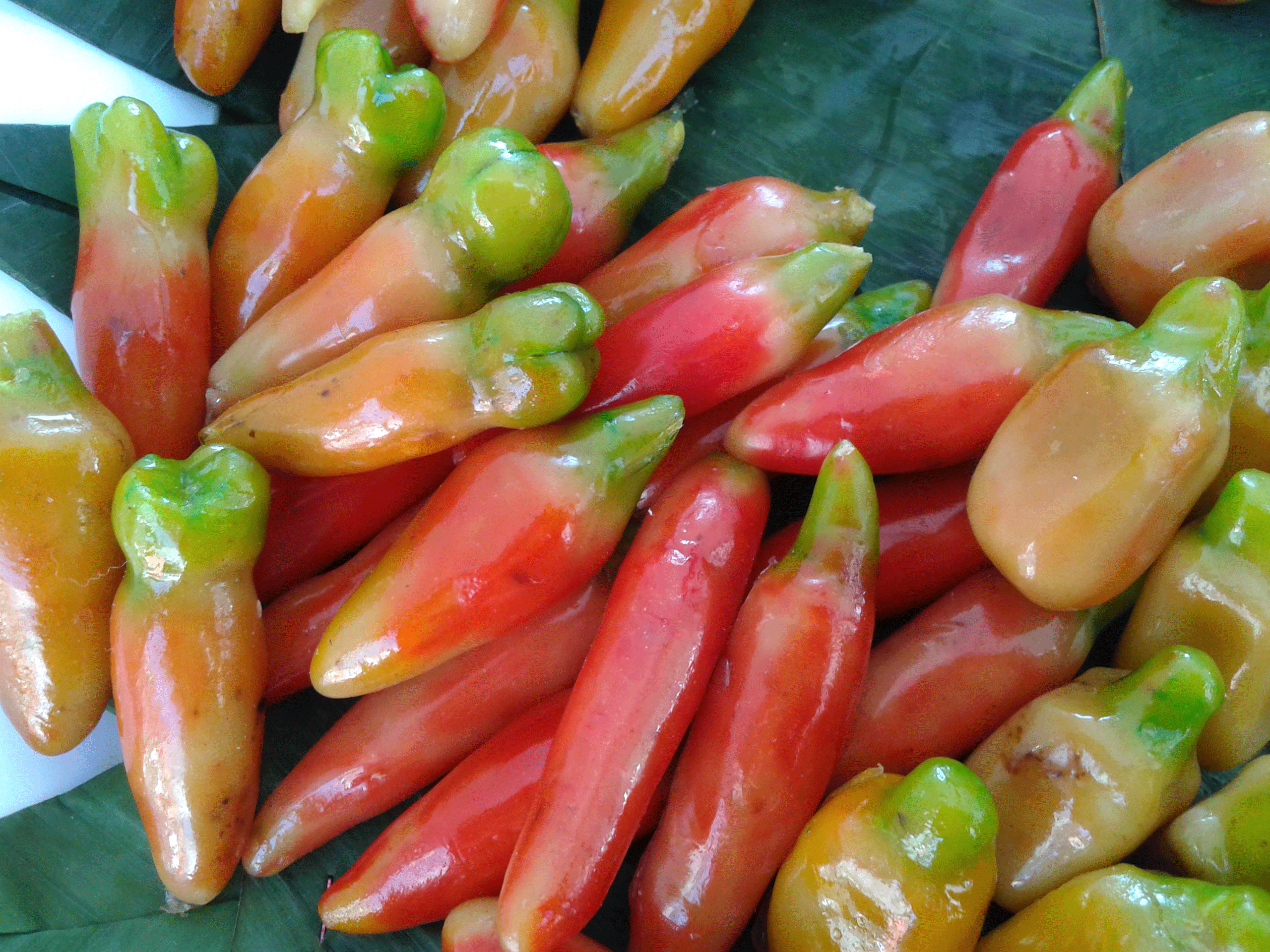
lokum, Turkish delight Turkey, Middle EastA confection made by thickening sugar syrup with starch yielding a very dense, chewy jelly. It is typically brightly colored and traditionally flavored with rosewater and mastic though contemporary confectioners have a much wider repertoire. Istanbul‘s premiere confectioner, Hacı Bekir offers some 2 dozen varieties.
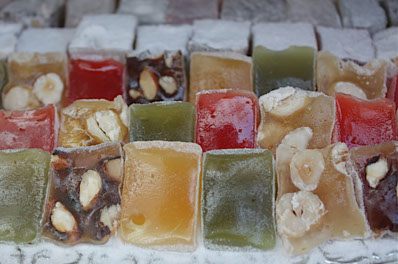
The origin of lokum is mostly likely medieval Persia, where a very similar confection called fālūdhaj, was made by thickening honey with starch.
luqmat al qadi Middle East, loukoumades Greece, lokma TurkeyA yeast-risen fritter made roughly the shape and size to a Ping-Pong ball. Once fried, it is soaked in sugar syrup. It makes its first appearance in a thirteenth-century recipe collection by al-Baghdadi, there called luqam al‐qādī or “judge’s morsel.”
macaron FranceAn almond meringue cookie. Two of these are often sandwiched around a flavored buttercream or ganache filling. Trendy variations have included everything from passion fruit to foie gras! The cookie seems to date to the Italian renaissance and was probably introduced in France in the late 16th or early 17th centuries. The name derives from the Italian maccheroni 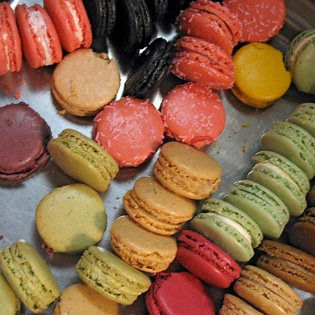 and may refer to the shape (early maccheroni were more like gnocchi than pasta) or perhaps they were originally made by the same Italian immigrants who sold maccheroni. Or both? Though macarons were being sandwiched with fruit preserves at least as early as the 19th century, the buttercream-filled variety only seems to date from the 1950’s. According to Ladurée (perhaps the earliest proponents of the modern filled macaron–see photo) it was Pierre Desfon-taines, a distant cousin of the Parisian shop’s first owner who came up with the idea.
and may refer to the shape (early maccheroni were more like gnocchi than pasta) or perhaps they were originally made by the same Italian immigrants who sold maccheroni. Or both? Though macarons were being sandwiched with fruit preserves at least as early as the 19th century, the buttercream-filled variety only seems to date from the 1950’s. According to Ladurée (perhaps the earliest proponents of the modern filled macaron–see photo) it was Pierre Desfon-taines, a distant cousin of the Parisian shop’s first owner who came up with the idea.
madeleine FranceA small cake/cookie made of a rich sponge cake batter in a special mold that resembles an elongated scallop. The cookie became a celebrity after Marcel Proust used it in the opening of his masterwork, A la récherche du temps perdu. According to the 19th century pastry chronicler Pierre Lacam, the cookie was “invented” by a pastry cook to Prince Talleyrand named Avice. “He had the idea of using tôt -fait or quatre-quarts mixture [the first is roughly pound cake, the second is similar with fewer eggs] for little cakes baked in an aspic mold. M. Boucher and Carême approved the idea. He gave the name of madeleines to these cakes.” (Lacam, Mémorial de la pâtisserie) The Comte de Courchamps, writing a couple of generations earlier, credits the name to a certain Madeleine Paumier (Néo-physiologie du goût, 311) who worked for madame Perrotin de Barmond at the court of Louis XV. (A popular claim has her based in Lorraine which doesn’t make a whole lot of sense.) Wherever the name comes from, the idea of baking little sponge cakes in molds goes back at least a hundred years earlier.
manju JapanBuns stuffed with sweet adzuki bean. “Before Edo period they had many different fillings, including vegetables.” Eric C. Rath, Food and Fantasy in Early Modern Japan (Berkeley: U. of California Press, 2010), 91.
marshmallow US, UK, guimauve FranceEarly on, marshmallows were a kind of throat lozenge made of the marsh mallow plant. Later versions were closer to the confection we would recognize today made by whipping up egg whites, sugar, and the sticky extrusion of the same plant. In the twentieth century industrially produced gelatin replaced the root extract.
marzipan Europecoming soon
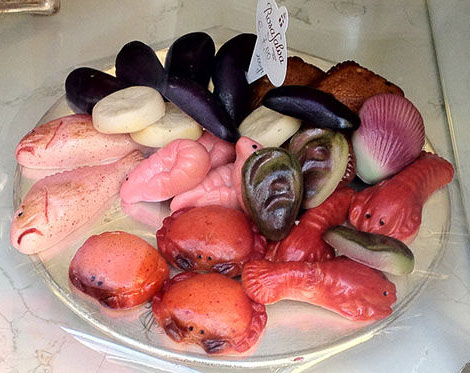
mazanec Czech Republic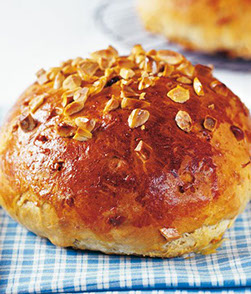 The mazanec is a cousin to the many sweet, enriched breads/cakes such as the panettone and paska typical of some European holidays. In this case it takes the form of a buttery yeast-leavened cake made in the form of a round loaf and is traditional for Easter. It is typically very lightly spiced with anise and nutmeg and generously studded with raisins and almonds.
The mazanec is a cousin to the many sweet, enriched breads/cakes such as the panettone and paska typical of some European holidays. In this case it takes the form of a buttery yeast-leavened cake made in the form of a round loaf and is traditional for Easter. It is typically very lightly spiced with anise and nutmeg and generously studded with raisins and almonds.
Photo: apetitonline.cz
meringuecoming soon...
mignardises FranceSweets that consist of one bite, smaller than petits fours. According to Sébastien Canonne, a founder of the French Pastry School in Chicago, the range has three basic categories: "sec (dry and crunchy, like tuiles or sables); moelleux (soft, like madeleines or financiers) or frais (with fresh ingredients like pastry cream or fruit, which must be eaten soon after they are combined, like eclairs and tarts).” NYT, 26 Oct. 2011
mishti doi South AsiaA Bengali dessert made by adding yogurt cultures to partially evaporated milk.
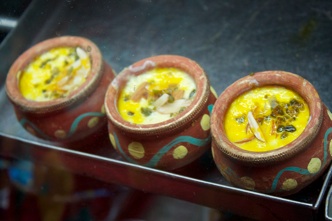
mochi JapanA sweet rice cake made with glutinous rice. The dough is often use to wrap a filling such as bean paste or more recently nuggets of ice cream. Similar rice flour doughs are used throughout East and South Asia.
moon pie USA sandwich cookie made with two round graham cracker-type layers that sandwich a filling of marshmallow. This is then dipped in chocolate or other flavors. Originated by the Chattanooga Bakery in 1917. Not to be confused with the “half-moon pie,” long a synonym for a turnover.
mousse Francecoming soon...
Napoleon US, millefeuille France, millefoglie ItalySheets of puff pastry are layered with vanilla pastry cream and then cut into single, rectangular-shaped portions. The filling is occasionally flavored with fruit and the top is often iced with fondant.
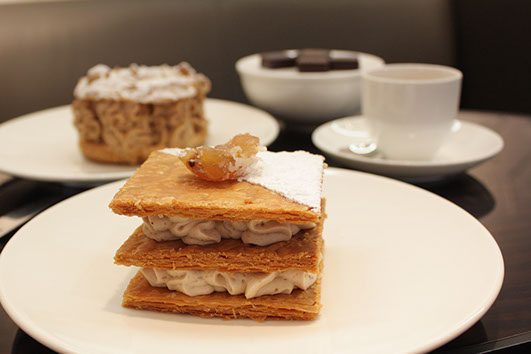
nātif Middle East (medieval)A nougat-like confection made with honey, egg whites and nuts, perfumed with musk, ambergris and mastic.
neige France (mostly 17th century)See ice cream.
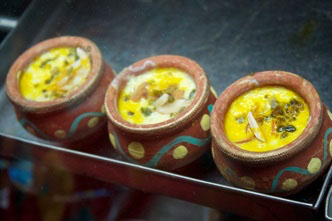
okashi JapanA general Japanese term encompassing all sorts of sweets and snacks. These can be both sweet and savory, ranging from candy bars to seaweed snacks.
olie bollen, oliekoecken NetherlandsLiterally “oil balls” or “oil cakes” these are the Dutch version of doughnuts. They are usually in the form of ping-pong-ball-sized fritter,, sprinkled generously with powdered sugar. For a 17th century recipe see Peter Rose’s translation at www.kookhistorie.nl. See also doughnuts.
Oreos USSandwich cookies made by the Nabisco Company since 1912. According to some accounts, more of these chocolate-colored disks filled with a shortening-based, vanillin-flavored “cream” have been sold than any other factory-made cookie (450 billion as of 2002). Presumably American children like them so much because they are fun to pull apart – it can’t possibly be the taste.
panforte Italy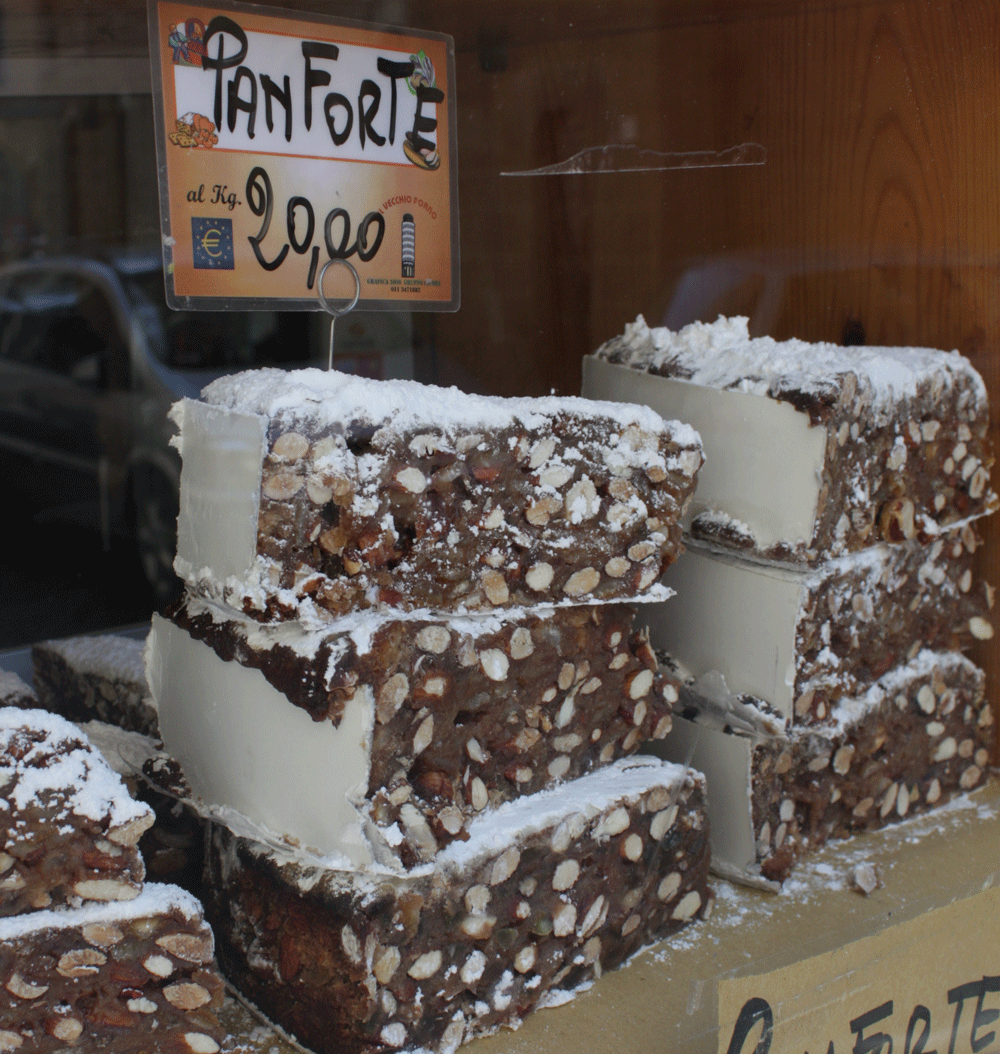 A very dense sweet fruitcake containing nuts and spices. It is conceivable that a similar confection was made in Sienna in the Middle Ages. A document as far back as 1205 lists something called panforte on a list of goods given to the local monks and nuns as a tithe, or tax. Of course it’s anybody’s guess just what went into that ancient panforte or whether it resembled today’s panforte in any way at all.
A very dense sweet fruitcake containing nuts and spices. It is conceivable that a similar confection was made in Sienna in the Middle Ages. A document as far back as 1205 lists something called panforte on a list of goods given to the local monks and nuns as a tithe, or tax. Of course it’s anybody’s guess just what went into that ancient panforte or whether it resembled today’s panforte in any way at all.
Pariser Creme AustriaSee ganache.
pastéis de nata PortugalConsidered by the Portuguese their national dessert, pastéis de nata are little puff pastry tarts filled with a egg-yolk-rich custard. The most famous (and perhaps the best?) are served at the venerable Pastéis de Belém in a Lisbon suburb where they are typically dusted with cinnamon and sugar. For a recipe see Leite’s Culinaria. Versions of the recipe appear as early as Domingos Rodrigues’ Arte de Cozhina (1680) which probably means they were around much earlier. They seemed to have been a popular export too, finding their way to Macau, Goa, Angola and Brazil and other spots where the Portuguese raised their flag. From Macau the little tarts were adopted by Cantonese bakers under the name dan tat.
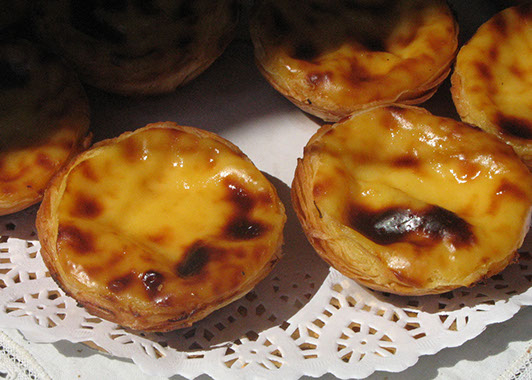
pastel de tres leches Latin Americacoming soon...
pavé de Venise FranceThis resembles a Napoleon constructed of layers of marsala-soaked spongecake and custard sandwiched by a top and bottom crust of puff pastry.
Pavlova New Zealand, Australia”A large meringue dessert cake said to emulate the lightness of the famous ballerina, Anna Pavlova” -- Helen Leach, The Pavlova Story (2008). What distinguishes the Pavlova from a Windtorte, say, is that the meringue is moist and marshmallow-like on the inside and crisp on the outside. It is usually topped with fruit and whipped cream. Australia and New Zealand both claim that it was invented there either in the 1920s or ‘30s.
pe de moleque BrazilLiterally “nigger foot” generally politely translated as street urchin/ragamuffin's foot. In the south of Brazil, this is a sort of peanut brittle while in the north it is a spice and nut cake made with manioc flour. For more see Flavors of Brazil. (Thanks to Scott Barton.)
peaches Melba US, UK, pêches Melba FrancePoached peaches are set on bed of sponge cake and ice cream then topped with raspberry sauce (or sometimes the reduced poaching liquid). The recipe was apparently invented at London’s Savoy Hotel by Auguste Escoffier in honor of the Australian soprano Nellie Melba. It had a great vogue the early part of the 20th century though seemingly more in the English-speaking world than in France. These days the sponge cake is most often omitted and other fruit such as strawberries substituted for the peaches.
pecan pie USA single crust pie filled with a egg-thickened filling based on syrup and pecans. The first recipes for the pie begin to show up around the turn of the 20th century. Presumably the origin is Louisiana where the pie is still sometimes made with cane syrup rather than the dark corn syrup which is now common.
pets de nonnes FranceLiterally “nun’s farts” these are relatively, small, choux pastry fritters. See also doughnuts.
pevarini ItalyA Venetian speciality, these take the form of large, dense cookies, about the size of a hockey puck. They are sweetened with molasses, spiked with pepper and typically studded with almonds and raisins.
picarones PeruFritters made with pumpkin or sweet potato.
pineapple upside-down cake United Statescoming soon...
polvorones Spain, MexicoAn almond shortbread-type cookie classically made with lard, though butter-based versions also exist. The name, which comes from the word for powder refers to their delicate, crumbly texture. see Times story http://www.nytimes.com/2013/12/24/business/international/sweets-made-only-for-christmas-are-spanish-towns-gift-to-itself.html?emc=edit_tnt_20131223&tntemail0=y
pop tarts US
Portugal cake US, UK (dated)This was popular cake on both sides of the Atlantic in the 1800’s. The recipe resembled a poundcake but enriched with sherry and currants. The cakes were baked in pans about the size of a madeleine mold.
pound cake US, UKA rich cake traditionally made with a pound each of butter, eggs, flour and sugar. Though most contemporary recipes are chemically leavened, older versions get their lift from only long, vigorous stirring. See, for example, Eliza Leslie’s 1836 recipe.
Priapus Ancient RomeA Roman pastry baked in the form of the god of fertility or sometimes just his pertinent member. Roman men ate it at the end of the meal to perk themselves up for post-prandial activities.
puff pastry US, UK, pâte feuilletée FrancePastry cooks have devised two broad ways of making flaky pastry: to make filo or strudel dough, a water and flour paste is rolled or stretched very thin and brushed with fat between each layer; to make puff pastry, the fat is enclosed in the paste and then the dough is repeatedly folded and rolled resulting in layers that puff up on baking. Just where this latter idea originated is a little unclear. The earliest recipe for what might be called puff pastry shows up in a 13th century Andalusian source. Here, a flour and water paste is smeared with fat, rolled up in a cylinder and then rolled out once again. This technique is still used to make the pastry for Portugal’s pastéis de nata as well as Naples’ sfogliatelle. Lancelot de Cousteau called this “Spanish puff pastry” (pastéz d’espaigne fueiltéz) in his 1604 French-language cookbook. The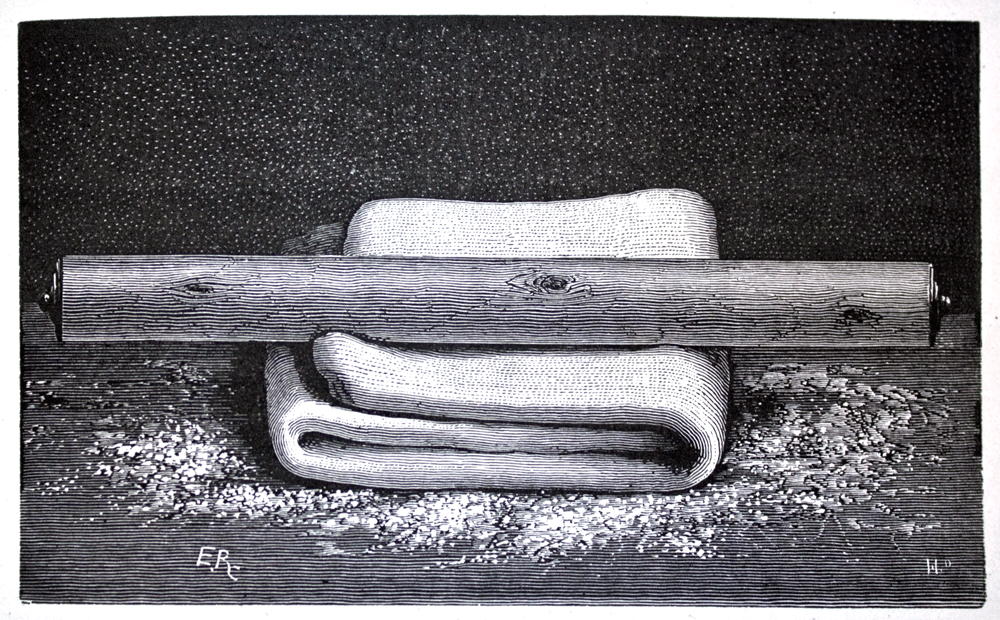 first recipe for honest to goodness French-style puff pastry that is repeatedly folded and rolled doesn’t show up until 50 years later. Did the French adapt the rolled Muslim Iberian version? Or did they come up with the folded version independently? There’s probably no way of knowing for sure.
first recipe for honest to goodness French-style puff pastry that is repeatedly folded and rolled doesn’t show up until 50 years later. Did the French adapt the rolled Muslim Iberian version? Or did they come up with the folded version independently? There’s probably no way of knowing for sure.
qatayif Middle EastThese half-moon shaped fritters are made by filling an eggless pancake with nuts or fresh cheese before frying. A syrup scented with orange flower water or rose water is usually drizzled over them. In many parts of the Middle East they are a traditional treat during Ramadan. Recipes for the pancakes themselves appear in sources as early as the ninth century.
queijadas de Alcobaça Portugal
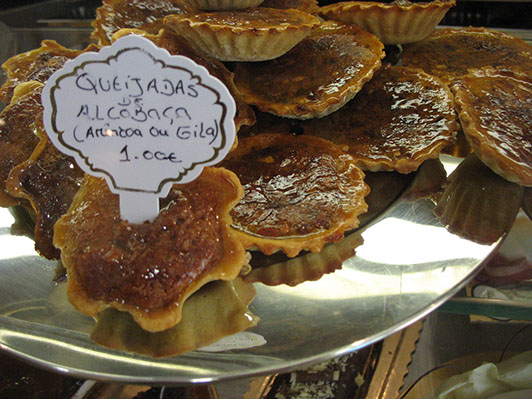
quejinhos do céu PortugalLiterally “little cheeses from heaven,” where the “cheese” is made with almond paste and the interior filled with a rich egg custard.
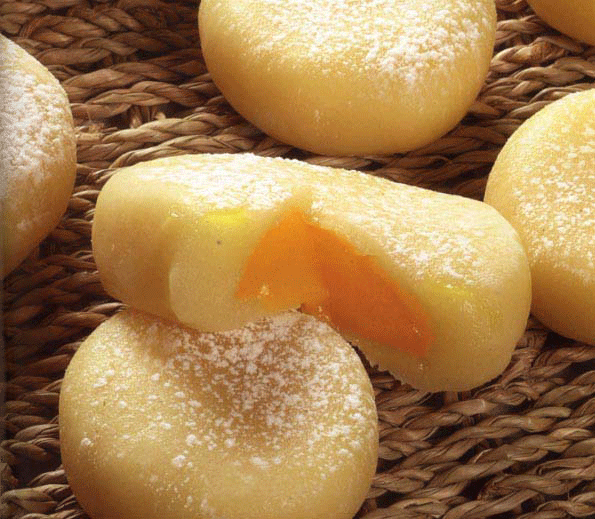
Photo: Antonio Rosado from Doçaria Conventual Portuguesa, 2004
rajbhog IndiaThis variation on rossogolla (see below) is dyed with saffron and filled with a nut mixture flavored with cardamom powder.
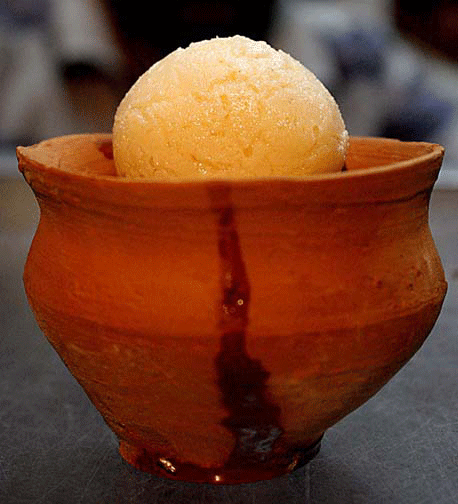
red velvet cake USA fluffy cake lightly flavored with cocoa and tinted red with food coloring. Often made into cupcakes. A cream-cheese based icing is typical. For an in depth article see Kim Severson's excellent NYT article, "Red Velvet Cake: From Gimmick to American Classic."
réligieuse FranceAs made today, the réligieuse is made by placing two glazed cream puffs one on top of the other. Originally, it was assembled out of éclairs into a sort of tepee that was meant to resemble a nun’s habit. According to the nineteenth-century pastry chef and author Pierre Lacam, the pastry was originally created at the Frascati patisserie in Paris in 1836.
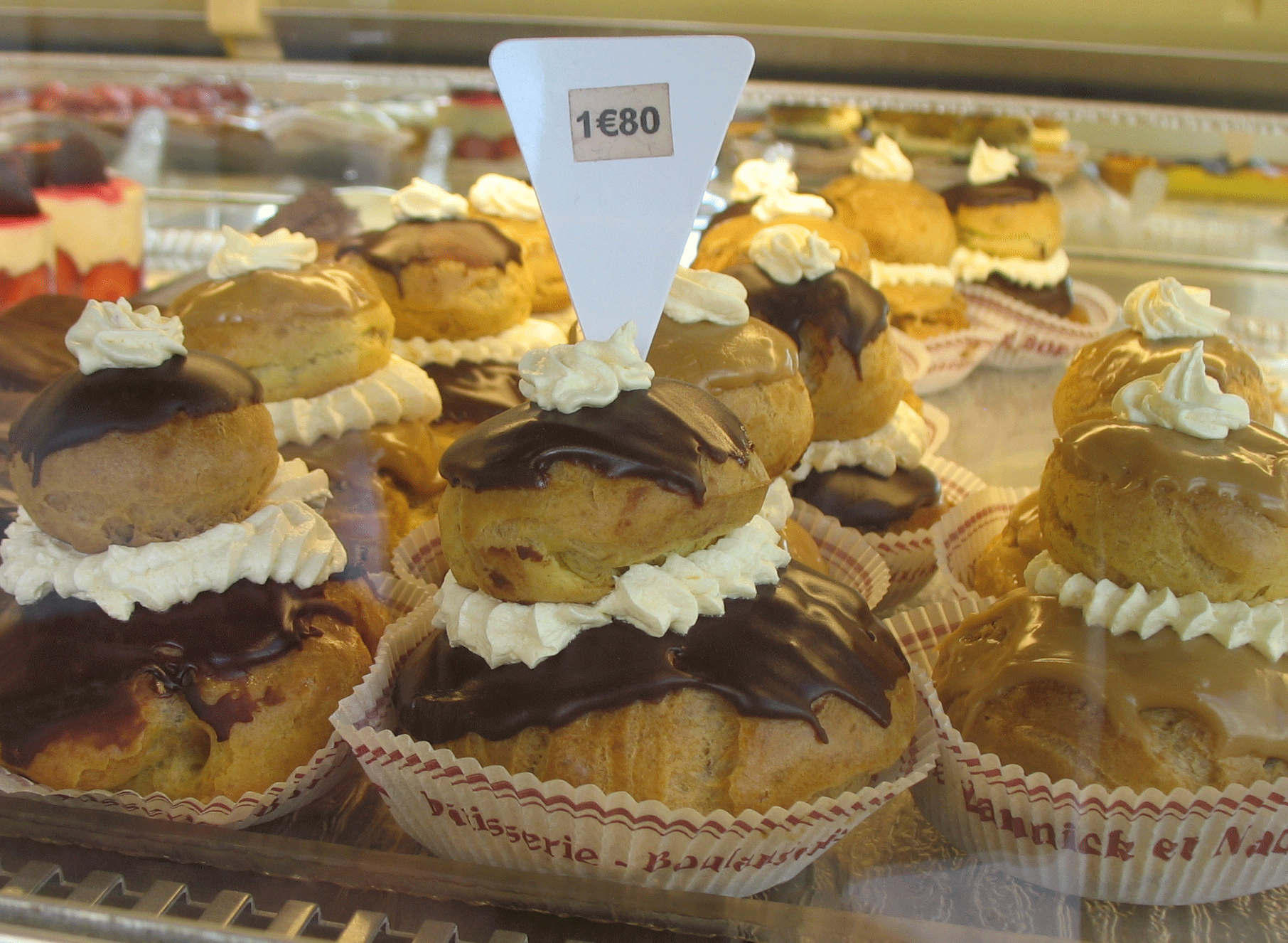
rétes HungarySee strudel.
Rice Krispies Treats USThe quintessentially American “homemade” dessert bar is made by stirring together melted marshmallows and Kellogg's® Rice Krispies®. The recipe (originally called “Rice Krispies Marshmallow Squares”) seems to have been invented in Kellogg’s test kitchens in the late 1930’s. according to the company website, they were first advertised in 1940. And advertised they were! Here is the recipe, straight from the corporate horse’s mouth.
rice pudding US, arroz con leche Latin America, Spain, riz au lait France, Sütlaç Turkeycoming soon...
roscos SpainA sort of egg-rich doughnut (made in the shape of a torus) and flavored with lemon rind and dusted with sugar. Current recipes tend to use baking powder as a leaven.
rossogolla, rasgula India, BangladeshA spongy dumpling made by boiling balls of fresh curd (chhana) in sugar syrup. In Kolkata, the invention of this local favorite is credited to Nobin Chandra Das who is said to have created it in 1868. However natives of nearby Orissa dispute this with great passion.
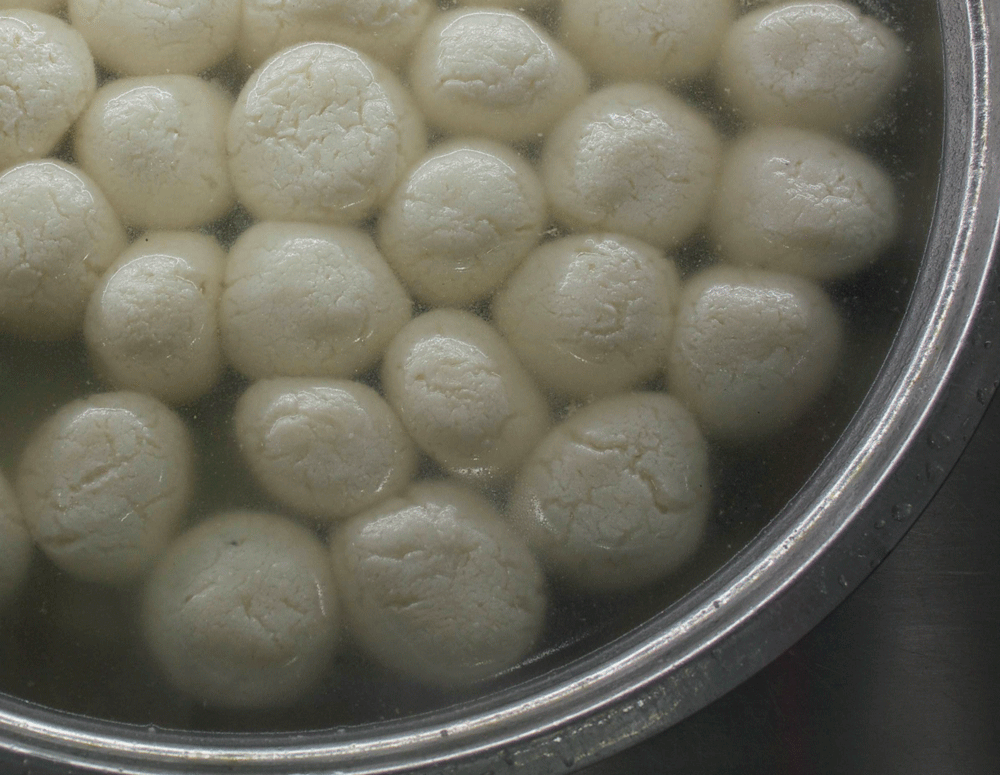
rossomalai IndiaThis is made exactly the same way as rossogolla except that in this case it is finished off in a milk-based and saffron-tinted syrup. The result is creamy, delicate, and a little like a French île flottante, but less insipid.
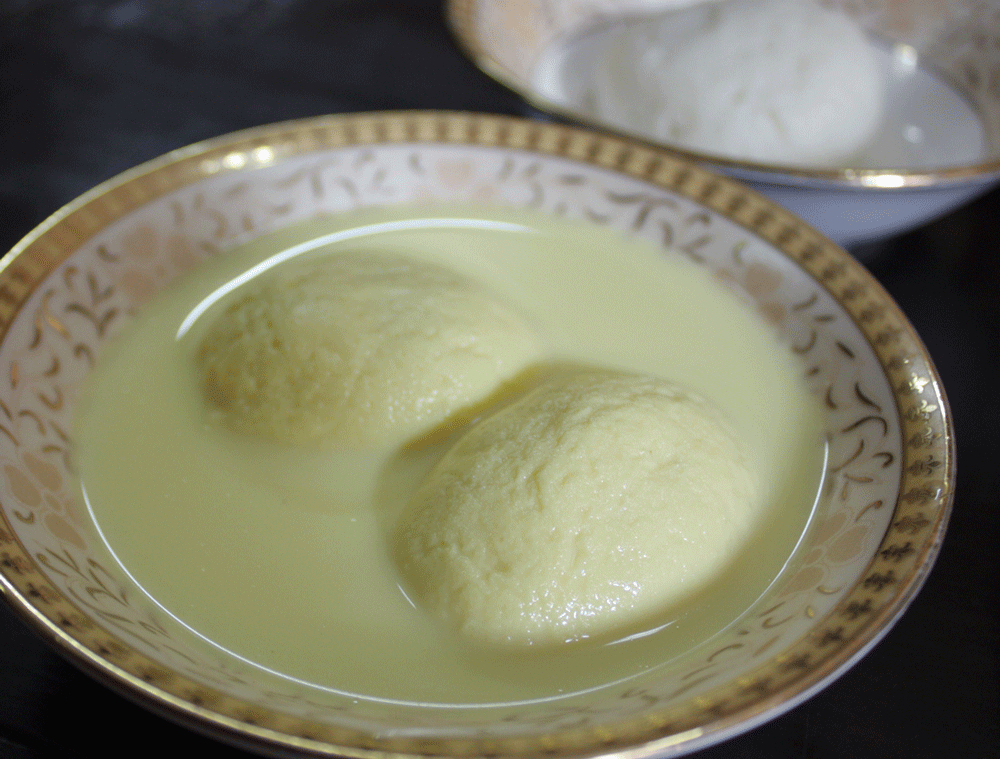
rout cake UKAn early (1800 or so?) drop cookie or small cake. Possibly the ancestor to the American drop cookie? The name comes from rout, “A fashionable gathering; a large evening party or soirée of a type fashionable in the 18th and early 19th centuries.” (OED) Jane Austen mentions “rout-cakes” in Emma.
Sachertorte (also Sacher-Torte) AustriaA chocolate sponge cake coated with apricot and then chocolate glaze. The cake is named after Franz Sacher (1816-1907) who is widely, credited with inventing the cake in 1832 for a dinner party hosted by the Austrian chancellor Klemens von Metternich. In the nineteenth century the cake consisted of one layer but some point in the 1920s (or perhaps earlier) the cake was split into two layers by the owners of the Sacher Hotel. This is the version the hotel sells as the Original Sacher-Torte™. Nonetheless the popular account of the cake’s history should be taken with a grain of salt. According to an interview with the nonagenarian Franz Sacher in 1906, he invented the cake somewhat later, sometime in the 1840’s while he ran a catering business in what is now Bratislava.
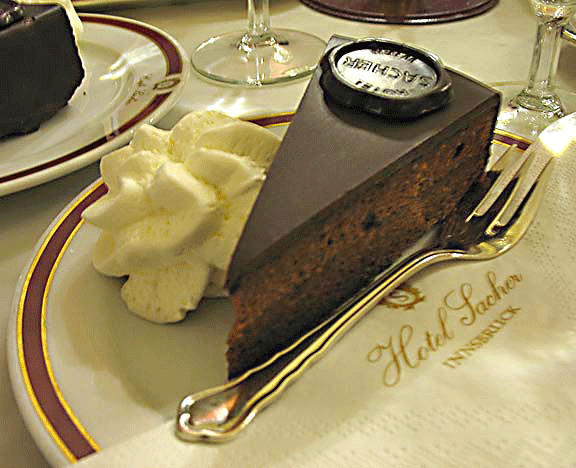
Sally Lunn US, UK (dated)A butter enriched, sweetened, yeast cake (or bread) popular in Britain and the United States in the nineteenth century. Often served for tea. According to the The Every-Day Book and Table Book (1827), p. 1562, ”The bun so fashionable, palled the Sally Lunn, originated with a young woman of that name in Bath, about thirty years ago. She first cried them, in a basket with a white cloth over it, morning and evening. Dalmer, a respectable baker and musician, noticed her, bought her business, and made a song, and set it to music in behalf of ‘Sally Lunn.’ This composition became the street favourite, barrows were made to distribute the nice cakes, Dalmer profited thereby, and retired; and, to this day, the Sally Lunn cake, not unlike the hotcross [sic] bun in flavour, claims preeminence in all the cities in England.”
savarin Francecoming soon...
scarcedda ItalyAn Easter dessert typical of Puglia. It is a sort of pie made by filling a short crust dough (flour, sugar, eggs, lard, lemon rind) with a sweetened ricotta filling. The top is typically decorated with one or more whole eggs. Other versions are made quite differently, resembling the Calabrian cuzzupa.
sfogliatelle ItalyA Neapolitan specialty made by enclosing a ricotta filling in a puff pastry cornet. The puff pastry itself is made in the older (Arabic?) technique by rolling out a cylinder of fat and dough layers. See puff pastry.
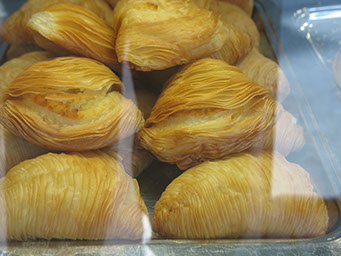
sgroppino ItalyA liquid lemon sorbetto from the northern region of the Veneto Italy. “It is basically an intermezzo drink to help move through different courses made of lemon sorbetto, prosecco wine and vodka. Stored frozen and served chilled in flute glasses.“ Thanks to Leonardo Mazzero
shaqima ChinaYou could describe this as a cross between zalabia and Rice Krispies Treats, made by frying yeast-leavened strips of wheat and egg dough, which are then coated with a dense syrup and packed into rectangular molds. See recipe.
sisi delle monache ItalyA specialty of Abruzzo, specifically the town of Guardiagrele, this dessert is made by sandwiching two large sponge cake cookies with pastry cream. Each small spongecake is in the form of three mounds, which is likely where name comes from, literally “nuns tits.” For more see Rossano Orlando, “Sise delle monache, la storia in un dolce,” Il Centro (16 November 2011).
Photo: Federico Deidda
s'mores US
sorbet France, US, ice UK, sorbetto ItalyA fruit or or other dairy-free frozen dessert made in an ice cream freezer. Before 1900 or so, confusion reigns when it comes to the term. Before about 1800 or so, in France, sorbet referred to a chilled soft drink and in Italy a sorbetto was largely indistinguishable from what we would call a gelato today.
soufflé Francecoming soon...
spongade Italy (16th-17th century)A late renaissance Venetian term used for sugar sculptures typically referred to elsewhere in Italy as trionfi. There were often designed by noted artists to be used as opulent centerpieces, and often gilded just to prove the host’s extravagance.
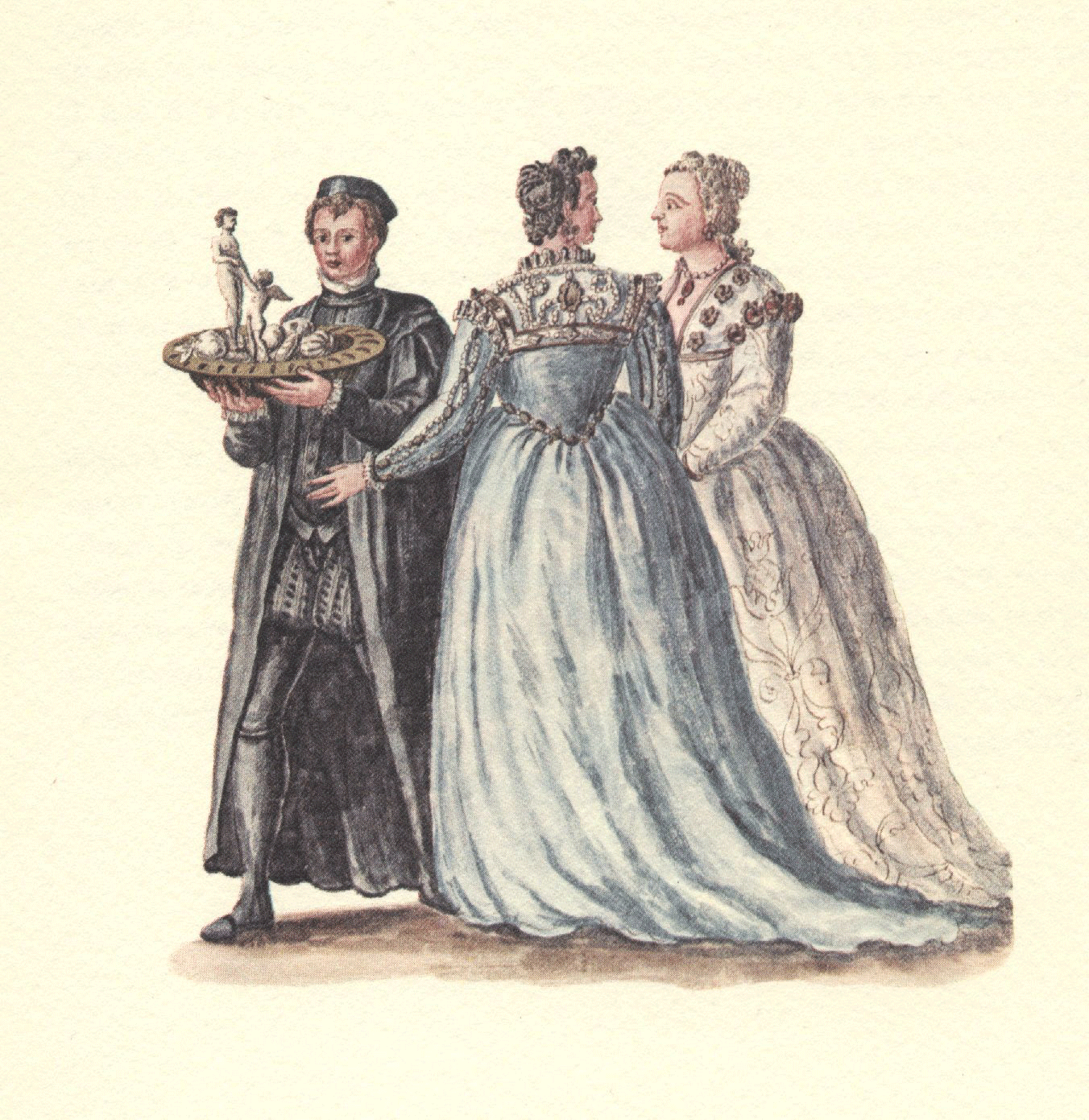
Engraving after Giovanni Grevembroch (18th Century)
sponge cake US, UK, génoise France, pan di spagna Italy, Biskuit Austria, Germany, bizcocho, vizcocho (dated) SpainSponge cake is made by beating eggs to a foam and then folding in flour, ground nuts, cocoa and/or other flavorings. A number of variations exist: sometimes the eggs are separated and the yolks and whites beaten individually, at other times the eggs are beaten whole, occasionally the eggs are beaten over a low heat source. The technique may well have originated in Spain since the earliest Italian recipes call it pan di Spagna or “bread of Spain” and early Portuguese recipes referred to it as paõ de Castella, or “bread of Castille.” The Japanese still call it castella. Since the recipe for pan di Spagna was used to make the more delicate kind of biscotti in renaissance Italy, the French picked up the habit of calling their egg-leavened cake biscuit, a term that, in France, had once referred exclusively to ship’s biscuit or hard tack. Eventually the term came to mean primarily small cakes or cookies.
spoom France?To make this semi-frozen dessert, fold Italian meringue into a semi-frozen dessert. The 1961 Larousse Gastronomique recommends sorbets based on fruit juices but also ones made with “champagne muscadet, Frontignan, sherry, port, etc.” Despite the odd name (perhaps from the Italian spuma, foam) the origin of the recipe is presumably French since it is listed on a 1905 menu at the Elysée Palace and the first mention in English is Escoffier’s 1907 . (OED) Thanks to Tina Drzal.
strawberry shortcake UScoming soon...
strudel Central Europe, rétes, HungaryTo make strudel, apples, cherries, cottage cheese and even cabbage are rolled in several layers of paper-thin dough. Though superficially similar to filo, strudel dough is stretched rather than rolled and may well have been developed independently in central or southeastern Europe. One of the earliest recipes for such a stretched dough appear in a dish called “Torta ungaresca” (Hungarian pie) in a 14th century source.
suspiros de Santa Catarina PortugalLiterally, “Saint Catherine’s sighs,” these are made by piping (French) meringue onto a thin wafer base. This is sprinkled with almonds and baked until crisp.
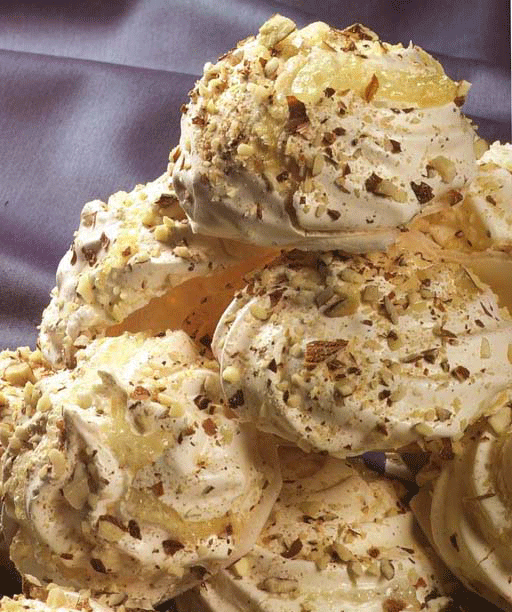
Photo: Antonio Rosado from Doçaria Conventual Portuguesa, 2004
Sussex pond pudding UKAn old-fashioned steamed pudding make by setting a whole lemon in a mixture of sugar and butter and encasing all this in suet pastry. The name presumably comes from the fact that when the pudding is sliced open, the marmelade-like filling spills out creating a sort of “pond” around the dessert. Thanks to Jennifer Yee.
taiyaki JapanA fish-shaped cake baked with a red bean paste filling.
tachinho de D. Abade Portugal
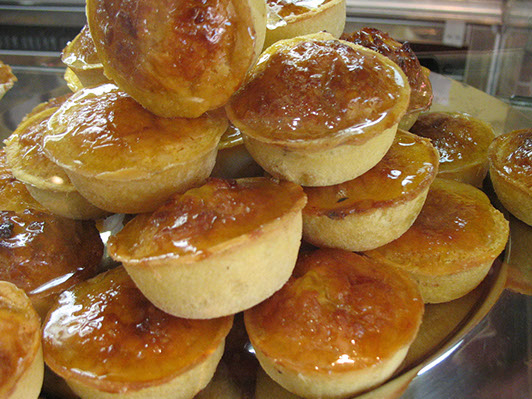
tavuk göğsü TurkeyA kind of pudding made with ground chicken breast, milk and almond The dish can be traced to medieval Arab recipes. Something similar was adopted under the the name blancmange, bianco-mangiare, etc. in medieval Europe where is was wildly popular for several centuries.
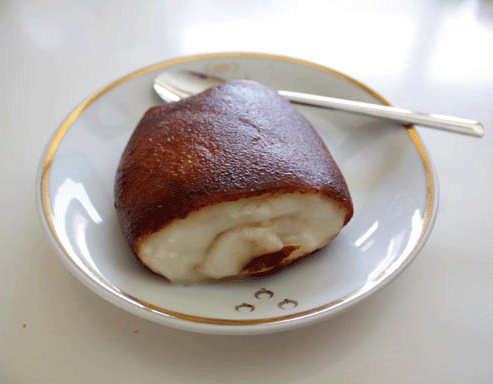
thong yawd ThailandTo make this dessert, tear-shaped drops of a yolk mixture are cooked in a sugar syrup. Very probably, the dessert is originally derived from a Portuguese technique used to make trouxas das caldas and similar egg-yolk based sweets.
thong yip ThailandThong yip (flower egg yolk tart) is based on egg yolks made with a jasmine-scented syrup. The dessert is popularly made on propitious occasions since its name begins with the word thong, meaning "gold." Thais believe that gold, symbolizing fame and wealth, will bring good luck.
tiramisù ItalyTiramisù, literally “pick-me-up,” is clearly a descendant of the earlier zuppa inglese. Here too are layers of sponge cake or ladyfingers, soaked with booze and layered with a creamy mixture. It’s just that mascarpone is used instead of custard, and coffee is added to the mix. The dessert is relatively new, appearing for the first time in Treviso in the 1960s; the recipe appeared in print only in 1981. There are several claimants who profess parentage. Giuseppe Maffioli, who first jotted down the rec- ipe, alleges that it was invented in 1961 at a Treviso restaurant called Alle Beccherie, by a pastry chef named Loly Linguanotto.
titola ItalyA small, sweet braided loaf that contains a colored egg, typical of Easter celebrations in Italy’s Friuli Venezia Giulia region.
Photo: Monica Rubino
(canali.kataweb.it)
Toll house cookie UScoming soon...
tong shui, tong sui ChinaA dessert soup or custard associated with Taiwan. These soups may be served hot or cold and include such ingredients as jellied bean curd, tapioca, snow fungus (a tropical tree fungus) and others.
trifle UKcoming soon...
Turkish delight Turkey, Middle EastSee lokum.
unni-āppam IndiaA spongy fritter made of rice flour, plantain, jackfruit, and jaggery (raw palm sugar). Apparently a favorite of the god Ganesh in parts of southern India.
vánočka Czech RepublicA braided, lightly sweetened and egg-enriched loaf traditional for Christmas. Nowadays these are available year-round.
verrine FranceThe verrine (from the word “verre,” glass) is essentially a sort of fancy parfait popularized by Pierre Hermé and other French chefs in the first decade of the 2000s. Typically, it consists of several levels of mousse, pastry cream, sponge cake, etc. layered in a transparent glass.
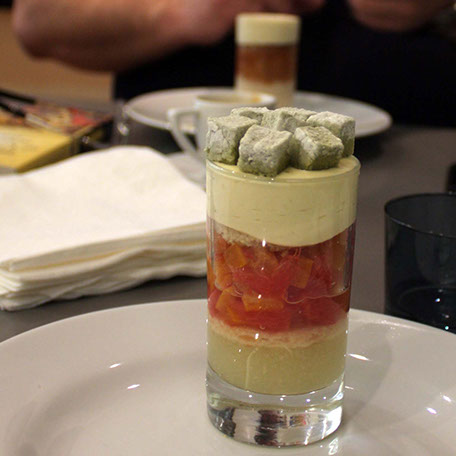
vizcocho SpainSee sponge cake.
wagashi JapanThe term for traditional Japanese sweets. The term is typically reserved for high-grade, elaborate confections while the more general term for snacks (including wagashi) is okashi. Wagashi tend to be made from traditional Japanese ingredients such as rice, beans, kanten (agar-agar), kuzu, sweet potatoes, sugar and fruit. These ingredients may be steamed, boiled, kneaded or dried.
Windtorte AustriaA large, crisp meringue shell designed to look like a cake, typically filled with fruit and whipped cream. The name seems to originate with 18th century meringue cookies called Spanische Winde a German term that referred to both the cookies and morning glories. Presumably the white cookies bore some resemblance to the flowers.
yassi kadayif TurkeyThe Turkish term for the Arab dessert qatayif.
yokan JapanThis takes the form of cubes, made from sweet, jellied adzuki bean paste and agar agar or kudzu starch. “When this dish arrived in Japan from China, it was a vegetarian substitute for mutton soup, as indicated by its name written using the Chinese character yo, meaning ‘sheep’ and the word kan for ‘soup.’” Eric C. Rath, Food and Fantasy in Early Modern Japan (2010), 91.
yufka TurkeyTurkish term for filo.
zabaglione Italy, sabayon Francecoming soon...
zalabia (also zalibīya) Middle EastA tangle of crispy dough made drizzling thinnish batter into hot fat. The fritter is then soaked in a sugar syrup. The fritters date back to at least Medieval Persia but are now widely dispersed across the Middle East and North Africa. The Indian jalebi is similar and probably a descendant of the Iranian original. In the Muslim world they are associated with Ramadan and among Syrian Jews with Hanukah.
zeppole ItalyFritters traditional to Naples made with a flour/water dough or cream puff dough (pâte à choux). The latter variant is often filled wither pastry cream and is traditional for St. Joseph’s Day, March 19. In the United States, zeppole are often made out of a yeast-leavened batter giving them a texture closer to doughnuts.
zerde TurkeyA dairy-free rice “pudding” made by thickening long-simmered rice with starch. In Turkey, zerde is traditional for weddings, births, and other special occasions.
Zimsterne Austria, Germany, Switzerland”Cinnamon stars,” are cookies popular throughout the German-speaking countries for the Christmas season. The recipe is typically made with a Linzer dough (see recipe) though a sugar-butter cookie dough is also occasionally used. Thanks to Kristin Buessing.
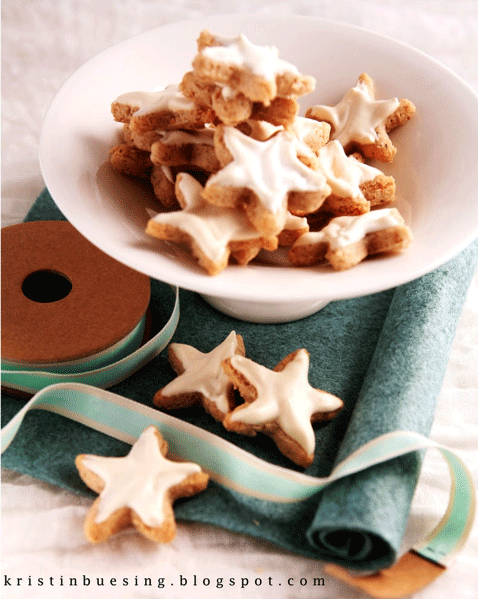
Photo: Kristin Buessing
Zimtringes AustiaLiterally “cinnamon rings.” A small ring-shaped cookie flavored with cinnamon popular around the turn of the 20th century.
znoud el set Middle EastLiterally “lady’s upper arms.” There are made by filling a filo cylinder with a cream filling.
zuccherini Italy (dated)Early version of meringue cookies. A recipe appears in Domenico Romoli’s cookbook, first published in 1560.
zuppa inglese Italycoming soon...















